Refine search
No keyword found to refine search
keywords EN
Places
Names
46 documents found
| 1 |
Documents per page :
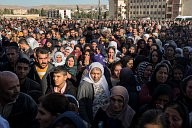
The uprising of the Kurds
Alexandre Afonso / Le Pictorium
LePictorium_0141225.jpg
The uprising of the Kurds: Diyarbakir and Nosaybin Kurds make up roughly one third out of Turkey's eighty million citizens. Though an almost absolute majority in the south-eastern provinces, they have hardly any rights and are faced with systemic discrimination that is coming to its tragic phase as testified in these images. Kurds have first tried political cooperation, the June elections for the first time brought a Kurdish party to the state parliament. This success and the possibility of a joint Turkish/Kurdish opposition as the Kurdish cause of political emancipation has rallied other minority and progressive votes inside the mainstream Turkish society frightenned the rulling AKP party, that before the repeated november elections – for they were unable to build a coalition- one sidedly ended the long ceasefire with the outlawed Workers party of Kurdistan (The PKK). Yet the Kurds were patient even during Ankara's unprovoked offensive, yet they succeeded in dividing the country among ethnic lines. After highly controversial elections that gave power to the AKP party, the Kurds were once again alone, if they could not strive for cooperation and a fairer Turkey, they should strive for autonomy. If the legal political activity of HDP party proved unsuccesfull, the initiative is once more on the PKK guerillas, if Turkey bombed the rural areas and mountain bases, the PKK resorted to a new tactic, trough their youth branches, they declared autonomy in certain urban centers, the heart of Kurdish community. Hope was that Turkey will be more lenient selective in attacking heavily populated areas as opposed to ruthlessly devastating the countryside far from any witnesses. This was not the case. Turkey responded with brutal force when attacking the guerillas seeking autonomy in their own community, aid workers are prohibited to access the wounded civilians caught in the crossfire, with dozens of dead each day. The official numbers are high enough yet they are impossible to determine as observers and journalists are denied access with threats of deportation or even physical harm while the locals who communicate with the press risk the possibility of a much more brutal consequences. The following photographs from Diyarbakir and Nosaybin, two of the seven cities that have districts under 24-hour curfews, cannot capture the conflict as one of the most oppressive regimes in history does everything in its power to make witnessing impossible. But the images do testify the conflict, as Ankara is using this conflict as an excuse for ethnic cleansing and general oppression of the Kurdish people. This is the only side that is accessible to the photojournalists. To make matters worse, most of the people in the photographs are forced to flee their homes for the second time in their lives. In the first uprising of the PKK in the nineties, Turkey used this as an excuse to empty the countryside, the cities in eastern Turkey tripled in size, now it's using the same excuse to reorganize the cities. The conflict is in its first phases yet its brutality is apparent, with reports of massacres by the government, mass deportations and general oppression in Turkish Kurdistan.
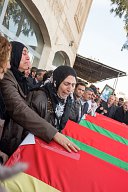
The uprising of the Kurds
Alexandre Afonso / Le Pictorium
LePictorium_0141226.jpg
The uprising of the Kurds: Diyarbakir and Nosaybin Kurds make up roughly one third out of Turkey's eighty million citizens. Though an almost absolute majority in the south-eastern provinces, they have hardly any rights and are faced with systemic discrimination that is coming to its tragic phase as testified in these images. Kurds have first tried political cooperation, the June elections for the first time brought a Kurdish party to the state parliament. This success and the possibility of a joint Turkish/Kurdish opposition as the Kurdish cause of political emancipation has rallied other minority and progressive votes inside the mainstream Turkish society frightenned the rulling AKP party, that before the repeated november elections – for they were unable to build a coalition- one sidedly ended the long ceasefire with the outlawed Workers party of Kurdistan (The PKK). Yet the Kurds were patient even during Ankara's unprovoked offensive, yet they succeeded in dividing the country among ethnic lines. After highly controversial elections that gave power to the AKP party, the Kurds were once again alone, if they could not strive for cooperation and a fairer Turkey, they should strive for autonomy. If the legal political activity of HDP party proved unsuccesfull, the initiative is once more on the PKK guerillas, if Turkey bombed the rural areas and mountain bases, the PKK resorted to a new tactic, trough their youth branches, they declared autonomy in certain urban centers, the heart of Kurdish community. Hope was that Turkey will be more lenient selective in attacking heavily populated areas as opposed to ruthlessly devastating the countryside far from any witnesses. This was not the case. Turkey responded with brutal force when attacking the guerillas seeking autonomy in their own community, aid workers are prohibited to access the wounded civilians caught in the crossfire, with dozens of dead each day. The official numbers are high enough yet they are impossible to determine as observers and journalists are denied access with threats of deportation or even physical harm while the locals who communicate with the press risk the possibility of a much more brutal consequences. The following photographs from Diyarbakir and Nosaybin, two of the seven cities that have districts under 24-hour curfews, cannot capture the conflict as one of the most oppressive regimes in history does everything in its power to make witnessing impossible. But the images do testify the conflict, as Ankara is using this conflict as an excuse for ethnic cleansing and general oppression of the Kurdish people. This is the only side that is accessible to the photojournalists. To make matters worse, most of the people in the photographs are forced to flee their homes for the second time in their lives. In the first uprising of the PKK in the nineties, Turkey used this as an excuse to empty the countryside, the cities in eastern Turkey tripled in size, now it's using the same excuse to reorganize the cities. The conflict is in its first phases yet its brutality is apparent, with reports of massacres by the government, mass deportations and general oppression in Turkish Kurdistan.
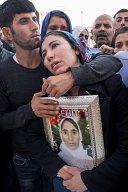
The uprising of the Kurds
Alexandre Afonso / Le Pictorium
LePictorium_0141227.jpg
The uprising of the Kurds: Diyarbakir and Nosaybin Kurds make up roughly one third out of Turkey's eighty million citizens. Though an almost absolute majority in the south-eastern provinces, they have hardly any rights and are faced with systemic discrimination that is coming to its tragic phase as testified in these images. Kurds have first tried political cooperation, the June elections for the first time brought a Kurdish party to the state parliament. This success and the possibility of a joint Turkish/Kurdish opposition as the Kurdish cause of political emancipation has rallied other minority and progressive votes inside the mainstream Turkish society frightenned the rulling AKP party, that before the repeated november elections – for they were unable to build a coalition- one sidedly ended the long ceasefire with the outlawed Workers party of Kurdistan (The PKK). Yet the Kurds were patient even during Ankara's unprovoked offensive, yet they succeeded in dividing the country among ethnic lines. After highly controversial elections that gave power to the AKP party, the Kurds were once again alone, if they could not strive for cooperation and a fairer Turkey, they should strive for autonomy. If the legal political activity of HDP party proved unsuccesfull, the initiative is once more on the PKK guerillas, if Turkey bombed the rural areas and mountain bases, the PKK resorted to a new tactic, trough their youth branches, they declared autonomy in certain urban centers, the heart of Kurdish community. Hope was that Turkey will be more lenient selective in attacking heavily populated areas as opposed to ruthlessly devastating the countryside far from any witnesses. This was not the case. Turkey responded with brutal force when attacking the guerillas seeking autonomy in their own community, aid workers are prohibited to access the wounded civilians caught in the crossfire, with dozens of dead each day. The official numbers are high enough yet they are impossible to determine as observers and journalists are denied access with threats of deportation or even physical harm while the locals who communicate with the press risk the possibility of a much more brutal consequences. The following photographs from Diyarbakir and Nosaybin, two of the seven cities that have districts under 24-hour curfews, cannot capture the conflict as one of the most oppressive regimes in history does everything in its power to make witnessing impossible. But the images do testify the conflict, as Ankara is using this conflict as an excuse for ethnic cleansing and general oppression of the Kurdish people. This is the only side that is accessible to the photojournalists. To make matters worse, most of the people in the photographs are forced to flee their homes for the second time in their lives. In the first uprising of the PKK in the nineties, Turkey used this as an excuse to empty the countryside, the cities in eastern Turkey tripled in size, now it's using the same excuse to reorganize the cities. The conflict is in its first phases yet its brutality is apparent, with reports of massacres by the government, mass deportations and general oppression in Turkish Kurdistan.
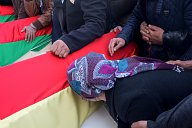
The uprising of the Kurds
Alexandre Afonso / Le Pictorium
LePictorium_0141228.jpg
The uprising of the Kurds: Diyarbakir and Nosaybin Kurds make up roughly one third out of Turkey's eighty million citizens. Though an almost absolute majority in the south-eastern provinces, they have hardly any rights and are faced with systemic discrimination that is coming to its tragic phase as testified in these images. Kurds have first tried political cooperation, the June elections for the first time brought a Kurdish party to the state parliament. This success and the possibility of a joint Turkish/Kurdish opposition as the Kurdish cause of political emancipation has rallied other minority and progressive votes inside the mainstream Turkish society frightenned the rulling AKP party, that before the repeated november elections – for they were unable to build a coalition- one sidedly ended the long ceasefire with the outlawed Workers party of Kurdistan (The PKK). Yet the Kurds were patient even during Ankara's unprovoked offensive, yet they succeeded in dividing the country among ethnic lines. After highly controversial elections that gave power to the AKP party, the Kurds were once again alone, if they could not strive for cooperation and a fairer Turkey, they should strive for autonomy. If the legal political activity of HDP party proved unsuccesfull, the initiative is once more on the PKK guerillas, if Turkey bombed the rural areas and mountain bases, the PKK resorted to a new tactic, trough their youth branches, they declared autonomy in certain urban centers, the heart of Kurdish community. Hope was that Turkey will be more lenient selective in attacking heavily populated areas as opposed to ruthlessly devastating the countryside far from any witnesses. This was not the case. Turkey responded with brutal force when attacking the guerillas seeking autonomy in their own community, aid workers are prohibited to access the wounded civilians caught in the crossfire, with dozens of dead each day. The official numbers are high enough yet they are impossible to determine as observers and journalists are denied access with threats of deportation or even physical harm while the locals who communicate with the press risk the possibility of a much more brutal consequences. The following photographs from Diyarbakir and Nosaybin, two of the seven cities that have districts under 24-hour curfews, cannot capture the conflict as one of the most oppressive regimes in history does everything in its power to make witnessing impossible. But the images do testify the conflict, as Ankara is using this conflict as an excuse for ethnic cleansing and general oppression of the Kurdish people. This is the only side that is accessible to the photojournalists. To make matters worse, most of the people in the photographs are forced to flee their homes for the second time in their lives. In the first uprising of the PKK in the nineties, Turkey used this as an excuse to empty the countryside, the cities in eastern Turkey tripled in size, now it's using the same excuse to reorganize the cities. The conflict is in its first phases yet its brutality is apparent, with reports of massacres by the government, mass deportations and general oppression in Turkish Kurdistan.
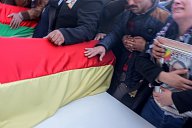
The uprising of the Kurds
Alexandre Afonso / Le Pictorium
LePictorium_0141229.jpg
The uprising of the Kurds: Diyarbakir and Nosaybin Kurds make up roughly one third out of Turkey's eighty million citizens. Though an almost absolute majority in the south-eastern provinces, they have hardly any rights and are faced with systemic discrimination that is coming to its tragic phase as testified in these images. Kurds have first tried political cooperation, the June elections for the first time brought a Kurdish party to the state parliament. This success and the possibility of a joint Turkish/Kurdish opposition as the Kurdish cause of political emancipation has rallied other minority and progressive votes inside the mainstream Turkish society frightenned the rulling AKP party, that before the repeated november elections – for they were unable to build a coalition- one sidedly ended the long ceasefire with the outlawed Workers party of Kurdistan (The PKK). Yet the Kurds were patient even during Ankara's unprovoked offensive, yet they succeeded in dividing the country among ethnic lines. After highly controversial elections that gave power to the AKP party, the Kurds were once again alone, if they could not strive for cooperation and a fairer Turkey, they should strive for autonomy. If the legal political activity of HDP party proved unsuccesfull, the initiative is once more on the PKK guerillas, if Turkey bombed the rural areas and mountain bases, the PKK resorted to a new tactic, trough their youth branches, they declared autonomy in certain urban centers, the heart of Kurdish community. Hope was that Turkey will be more lenient selective in attacking heavily populated areas as opposed to ruthlessly devastating the countryside far from any witnesses. This was not the case. Turkey responded with brutal force when attacking the guerillas seeking autonomy in their own community, aid workers are prohibited to access the wounded civilians caught in the crossfire, with dozens of dead each day. The official numbers are high enough yet they are impossible to determine as observers and journalists are denied access with threats of deportation or even physical harm while the locals who communicate with the press risk the possibility of a much more brutal consequences. The following photographs from Diyarbakir and Nosaybin, two of the seven cities that have districts under 24-hour curfews, cannot capture the conflict as one of the most oppressive regimes in history does everything in its power to make witnessing impossible. But the images do testify the conflict, as Ankara is using this conflict as an excuse for ethnic cleansing and general oppression of the Kurdish people. This is the only side that is accessible to the photojournalists. To make matters worse, most of the people in the photographs are forced to flee their homes for the second time in their lives. In the first uprising of the PKK in the nineties, Turkey used this as an excuse to empty the countryside, the cities in eastern Turkey tripled in size, now it's using the same excuse to reorganize the cities. The conflict is in its first phases yet its brutality is apparent, with reports of massacres by the government, mass deportations and general oppression in Turkish Kurdistan.
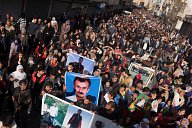
The uprising of the Kurds
Alexandre Afonso / Le Pictorium
LePictorium_0141230.jpg
The uprising of the Kurds: Diyarbakir and Nosaybin Kurds make up roughly one third out of Turkey's eighty million citizens. Though an almost absolute majority in the south-eastern provinces, they have hardly any rights and are faced with systemic discrimination that is coming to its tragic phase as testified in these images. Kurds have first tried political cooperation, the June elections for the first time brought a Kurdish party to the state parliament. This success and the possibility of a joint Turkish/Kurdish opposition as the Kurdish cause of political emancipation has rallied other minority and progressive votes inside the mainstream Turkish society frightenned the rulling AKP party, that before the repeated november elections – for they were unable to build a coalition- one sidedly ended the long ceasefire with the outlawed Workers party of Kurdistan (The PKK). Yet the Kurds were patient even during Ankara's unprovoked offensive, yet they succeeded in dividing the country among ethnic lines. After highly controversial elections that gave power to the AKP party, the Kurds were once again alone, if they could not strive for cooperation and a fairer Turkey, they should strive for autonomy. If the legal political activity of HDP party proved unsuccesfull, the initiative is once more on the PKK guerillas, if Turkey bombed the rural areas and mountain bases, the PKK resorted to a new tactic, trough their youth branches, they declared autonomy in certain urban centers, the heart of Kurdish community. Hope was that Turkey will be more lenient selective in attacking heavily populated areas as opposed to ruthlessly devastating the countryside far from any witnesses. This was not the case. Turkey responded with brutal force when attacking the guerillas seeking autonomy in their own community, aid workers are prohibited to access the wounded civilians caught in the crossfire, with dozens of dead each day. The official numbers are high enough yet they are impossible to determine as observers and journalists are denied access with threats of deportation or even physical harm while the locals who communicate with the press risk the possibility of a much more brutal consequences. The following photographs from Diyarbakir and Nosaybin, two of the seven cities that have districts under 24-hour curfews, cannot capture the conflict as one of the most oppressive regimes in history does everything in its power to make witnessing impossible. But the images do testify the conflict, as Ankara is using this conflict as an excuse for ethnic cleansing and general oppression of the Kurdish people. This is the only side that is accessible to the photojournalists. To make matters worse, most of the people in the photographs are forced to flee their homes for the second time in their lives. In the first uprising of the PKK in the nineties, Turkey used this as an excuse to empty the countryside, the cities in eastern Turkey tripled in size, now it's using the same excuse to reorganize the cities. The conflict is in its first phases yet its brutality is apparent, with reports of massacres by the government, mass deportations and general oppression in Turkish Kurdistan.
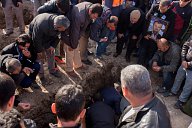
The uprising of the Kurds
Alexandre Afonso / Le Pictorium
LePictorium_0141231.jpg
The uprising of the Kurds: Diyarbakir and Nosaybin Kurds make up roughly one third out of Turkey's eighty million citizens. Though an almost absolute majority in the south-eastern provinces, they have hardly any rights and are faced with systemic discrimination that is coming to its tragic phase as testified in these images. Kurds have first tried political cooperation, the June elections for the first time brought a Kurdish party to the state parliament. This success and the possibility of a joint Turkish/Kurdish opposition as the Kurdish cause of political emancipation has rallied other minority and progressive votes inside the mainstream Turkish society frightenned the rulling AKP party, that before the repeated november elections – for they were unable to build a coalition- one sidedly ended the long ceasefire with the outlawed Workers party of Kurdistan (The PKK). Yet the Kurds were patient even during Ankara's unprovoked offensive, yet they succeeded in dividing the country among ethnic lines. After highly controversial elections that gave power to the AKP party, the Kurds were once again alone, if they could not strive for cooperation and a fairer Turkey, they should strive for autonomy. If the legal political activity of HDP party proved unsuccesfull, the initiative is once more on the PKK guerillas, if Turkey bombed the rural areas and mountain bases, the PKK resorted to a new tactic, trough their youth branches, they declared autonomy in certain urban centers, the heart of Kurdish community. Hope was that Turkey will be more lenient selective in attacking heavily populated areas as opposed to ruthlessly devastating the countryside far from any witnesses. This was not the case. Turkey responded with brutal force when attacking the guerillas seeking autonomy in their own community, aid workers are prohibited to access the wounded civilians caught in the crossfire, with dozens of dead each day. The official numbers are high enough yet they are impossible to determine as observers and journalists are denied access with threats of deportation or even physical harm while the locals who communicate with the press risk the possibility of a much more brutal consequences. The following photographs from Diyarbakir and Nosaybin, two of the seven cities that have districts under 24-hour curfews, cannot capture the conflict as one of the most oppressive regimes in history does everything in its power to make witnessing impossible. But the images do testify the conflict, as Ankara is using this conflict as an excuse for ethnic cleansing and general oppression of the Kurdish people. This is the only side that is accessible to the photojournalists. To make matters worse, most of the people in the photographs are forced to flee their homes for the second time in their lives. In the first uprising of the PKK in the nineties, Turkey used this as an excuse to empty the countryside, the cities in eastern Turkey tripled in size, now it's using the same excuse to reorganize the cities. The conflict is in its first phases yet its brutality is apparent, with reports of massacres by the government, mass deportations and general oppression in Turkish Kurdistan.
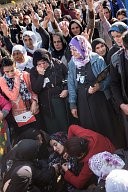
The uprising of the Kurds
Alexandre Afonso / Le Pictorium
LePictorium_0141232.jpg
The uprising of the Kurds: Diyarbakir and Nosaybin Kurds make up roughly one third out of Turkey's eighty million citizens. Though an almost absolute majority in the south-eastern provinces, they have hardly any rights and are faced with systemic discrimination that is coming to its tragic phase as testified in these images. Kurds have first tried political cooperation, the June elections for the first time brought a Kurdish party to the state parliament. This success and the possibility of a joint Turkish/Kurdish opposition as the Kurdish cause of political emancipation has rallied other minority and progressive votes inside the mainstream Turkish society frightenned the rulling AKP party, that before the repeated november elections – for they were unable to build a coalition- one sidedly ended the long ceasefire with the outlawed Workers party of Kurdistan (The PKK). Yet the Kurds were patient even during Ankara's unprovoked offensive, yet they succeeded in dividing the country among ethnic lines. After highly controversial elections that gave power to the AKP party, the Kurds were once again alone, if they could not strive for cooperation and a fairer Turkey, they should strive for autonomy. If the legal political activity of HDP party proved unsuccesfull, the initiative is once more on the PKK guerillas, if Turkey bombed the rural areas and mountain bases, the PKK resorted to a new tactic, trough their youth branches, they declared autonomy in certain urban centers, the heart of Kurdish community. Hope was that Turkey will be more lenient selective in attacking heavily populated areas as opposed to ruthlessly devastating the countryside far from any witnesses. This was not the case. Turkey responded with brutal force when attacking the guerillas seeking autonomy in their own community, aid workers are prohibited to access the wounded civilians caught in the crossfire, with dozens of dead each day. The official numbers are high enough yet they are impossible to determine as observers and journalists are denied access with threats of deportation or even physical harm while the locals who communicate with the press risk the possibility of a much more brutal consequences. The following photographs from Diyarbakir and Nosaybin, two of the seven cities that have districts under 24-hour curfews, cannot capture the conflict as one of the most oppressive regimes in history does everything in its power to make witnessing impossible. But the images do testify the conflict, as Ankara is using this conflict as an excuse for ethnic cleansing and general oppression of the Kurdish people. This is the only side that is accessible to the photojournalists. To make matters worse, most of the people in the photographs are forced to flee their homes for the second time in their lives. In the first uprising of the PKK in the nineties, Turkey used this as an excuse to empty the countryside, the cities in eastern Turkey tripled in size, now it's using the same excuse to reorganize the cities. The conflict is in its first phases yet its brutality is apparent, with reports of massacres by the government, mass deportations and general oppression in Turkish Kurdistan.
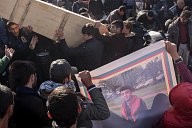
The uprising of the Kurds
Alexandre Afonso / Le Pictorium
LePictorium_0141233.jpg
The uprising of the Kurds: Diyarbakir and Nosaybin Kurds make up roughly one third out of Turkey's eighty million citizens. Though an almost absolute majority in the south-eastern provinces, they have hardly any rights and are faced with systemic discrimination that is coming to its tragic phase as testified in these images. Kurds have first tried political cooperation, the June elections for the first time brought a Kurdish party to the state parliament. This success and the possibility of a joint Turkish/Kurdish opposition as the Kurdish cause of political emancipation has rallied other minority and progressive votes inside the mainstream Turkish society frightenned the rulling AKP party, that before the repeated november elections – for they were unable to build a coalition- one sidedly ended the long ceasefire with the outlawed Workers party of Kurdistan (The PKK). Yet the Kurds were patient even during Ankara's unprovoked offensive, yet they succeeded in dividing the country among ethnic lines. After highly controversial elections that gave power to the AKP party, the Kurds were once again alone, if they could not strive for cooperation and a fairer Turkey, they should strive for autonomy. If the legal political activity of HDP party proved unsuccesfull, the initiative is once more on the PKK guerillas, if Turkey bombed the rural areas and mountain bases, the PKK resorted to a new tactic, trough their youth branches, they declared autonomy in certain urban centers, the heart of Kurdish community. Hope was that Turkey will be more lenient selective in attacking heavily populated areas as opposed to ruthlessly devastating the countryside far from any witnesses. This was not the case. Turkey responded with brutal force when attacking the guerillas seeking autonomy in their own community, aid workers are prohibited to access the wounded civilians caught in the crossfire, with dozens of dead each day. The official numbers are high enough yet they are impossible to determine as observers and journalists are denied access with threats of deportation or even physical harm while the locals who communicate with the press risk the possibility of a much more brutal consequences. The following photographs from Diyarbakir and Nosaybin, two of the seven cities that have districts under 24-hour curfews, cannot capture the conflict as one of the most oppressive regimes in history does everything in its power to make witnessing impossible. But the images do testify the conflict, as Ankara is using this conflict as an excuse for ethnic cleansing and general oppression of the Kurdish people. This is the only side that is accessible to the photojournalists. To make matters worse, most of the people in the photographs are forced to flee their homes for the second time in their lives. In the first uprising of the PKK in the nineties, Turkey used this as an excuse to empty the countryside, the cities in eastern Turkey tripled in size, now it's using the same excuse to reorganize the cities. The conflict is in its first phases yet its brutality is apparent, with reports of massacres by the government, mass deportations and general oppression in Turkish Kurdistan.
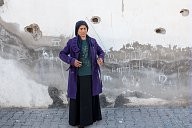
The uprising of the Kurds
Alexandre Afonso / Le Pictorium
LePictorium_0141234.jpg
The uprising of the Kurds: Diyarbakir and Nosaybin Kurds make up roughly one third out of Turkey's eighty million citizens. Though an almost absolute majority in the south-eastern provinces, they have hardly any rights and are faced with systemic discrimination that is coming to its tragic phase as testified in these images. Kurds have first tried political cooperation, the June elections for the first time brought a Kurdish party to the state parliament. This success and the possibility of a joint Turkish/Kurdish opposition as the Kurdish cause of political emancipation has rallied other minority and progressive votes inside the mainstream Turkish society frightenned the rulling AKP party, that before the repeated november elections – for they were unable to build a coalition- one sidedly ended the long ceasefire with the outlawed Workers party of Kurdistan (The PKK). Yet the Kurds were patient even during Ankara's unprovoked offensive, yet they succeeded in dividing the country among ethnic lines. After highly controversial elections that gave power to the AKP party, the Kurds were once again alone, if they could not strive for cooperation and a fairer Turkey, they should strive for autonomy. If the legal political activity of HDP party proved unsuccesfull, the initiative is once more on the PKK guerillas, if Turkey bombed the rural areas and mountain bases, the PKK resorted to a new tactic, trough their youth branches, they declared autonomy in certain urban centers, the heart of Kurdish community. Hope was that Turkey will be more lenient selective in attacking heavily populated areas as opposed to ruthlessly devastating the countryside far from any witnesses. This was not the case. Turkey responded with brutal force when attacking the guerillas seeking autonomy in their own community, aid workers are prohibited to access the wounded civilians caught in the crossfire, with dozens of dead each day. The official numbers are high enough yet they are impossible to determine as observers and journalists are denied access with threats of deportation or even physical harm while the locals who communicate with the press risk the possibility of a much more brutal consequences. The following photographs from Diyarbakir and Nosaybin, two of the seven cities that have districts under 24-hour curfews, cannot capture the conflict as one of the most oppressive regimes in history does everything in its power to make witnessing impossible. But the images do testify the conflict, as Ankara is using this conflict as an excuse for ethnic cleansing and general oppression of the Kurdish people. This is the only side that is accessible to the photojournalists. To make matters worse, most of the people in the photographs are forced to flee their homes for the second time in their lives. In the first uprising of the PKK in the nineties, Turkey used this as an excuse to empty the countryside, the cities in eastern Turkey tripled in size, now it's using the same excuse to reorganize the cities. The conflict is in its first phases yet its brutality is apparent, with reports of massacres by the government, mass deportations and general oppression in Turkish Kurdistan.
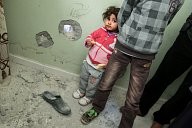
The uprising of the Kurds
Alexandre Afonso / Le Pictorium
LePictorium_0141235.jpg
The uprising of the Kurds: Diyarbakir and Nosaybin Kurds make up roughly one third out of Turkey's eighty million citizens. Though an almost absolute majority in the south-eastern provinces, they have hardly any rights and are faced with systemic discrimination that is coming to its tragic phase as testified in these images. Kurds have first tried political cooperation, the June elections for the first time brought a Kurdish party to the state parliament. This success and the possibility of a joint Turkish/Kurdish opposition as the Kurdish cause of political emancipation has rallied other minority and progressive votes inside the mainstream Turkish society frightenned the rulling AKP party, that before the repeated november elections – for they were unable to build a coalition- one sidedly ended the long ceasefire with the outlawed Workers party of Kurdistan (The PKK). Yet the Kurds were patient even during Ankara's unprovoked offensive, yet they succeeded in dividing the country among ethnic lines. After highly controversial elections that gave power to the AKP party, the Kurds were once again alone, if they could not strive for cooperation and a fairer Turkey, they should strive for autonomy. If the legal political activity of HDP party proved unsuccesfull, the initiative is once more on the PKK guerillas, if Turkey bombed the rural areas and mountain bases, the PKK resorted to a new tactic, trough their youth branches, they declared autonomy in certain urban centers, the heart of Kurdish community. Hope was that Turkey will be more lenient selective in attacking heavily populated areas as opposed to ruthlessly devastating the countryside far from any witnesses. This was not the case. Turkey responded with brutal force when attacking the guerillas seeking autonomy in their own community, aid workers are prohibited to access the wounded civilians caught in the crossfire, with dozens of dead each day. The official numbers are high enough yet they are impossible to determine as observers and journalists are denied access with threats of deportation or even physical harm while the locals who communicate with the press risk the possibility of a much more brutal consequences. The following photographs from Diyarbakir and Nosaybin, two of the seven cities that have districts under 24-hour curfews, cannot capture the conflict as one of the most oppressive regimes in history does everything in its power to make witnessing impossible. But the images do testify the conflict, as Ankara is using this conflict as an excuse for ethnic cleansing and general oppression of the Kurdish people. This is the only side that is accessible to the photojournalists. To make matters worse, most of the people in the photographs are forced to flee their homes for the second time in their lives. In the first uprising of the PKK in the nineties, Turkey used this as an excuse to empty the countryside, the cities in eastern Turkey tripled in size, now it's using the same excuse to reorganize the cities. The conflict is in its first phases yet its brutality is apparent, with reports of massacres by the government, mass deportations and general oppression in Turkish Kurdistan.
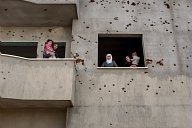
The uprising of the Kurds
Alexandre Afonso / Le Pictorium
LePictorium_0141236.jpg
The uprising of the Kurds: Diyarbakir and Nosaybin Kurds make up roughly one third out of Turkey's eighty million citizens. Though an almost absolute majority in the south-eastern provinces, they have hardly any rights and are faced with systemic discrimination that is coming to its tragic phase as testified in these images. Kurds have first tried political cooperation, the June elections for the first time brought a Kurdish party to the state parliament. This success and the possibility of a joint Turkish/Kurdish opposition as the Kurdish cause of political emancipation has rallied other minority and progressive votes inside the mainstream Turkish society frightenned the rulling AKP party, that before the repeated november elections – for they were unable to build a coalition- one sidedly ended the long ceasefire with the outlawed Workers party of Kurdistan (The PKK). Yet the Kurds were patient even during Ankara's unprovoked offensive, yet they succeeded in dividing the country among ethnic lines. After highly controversial elections that gave power to the AKP party, the Kurds were once again alone, if they could not strive for cooperation and a fairer Turkey, they should strive for autonomy. If the legal political activity of HDP party proved unsuccesfull, the initiative is once more on the PKK guerillas, if Turkey bombed the rural areas and mountain bases, the PKK resorted to a new tactic, trough their youth branches, they declared autonomy in certain urban centers, the heart of Kurdish community. Hope was that Turkey will be more lenient selective in attacking heavily populated areas as opposed to ruthlessly devastating the countryside far from any witnesses. This was not the case. Turkey responded with brutal force when attacking the guerillas seeking autonomy in their own community, aid workers are prohibited to access the wounded civilians caught in the crossfire, with dozens of dead each day. The official numbers are high enough yet they are impossible to determine as observers and journalists are denied access with threats of deportation or even physical harm while the locals who communicate with the press risk the possibility of a much more brutal consequences. The following photographs from Diyarbakir and Nosaybin, two of the seven cities that have districts under 24-hour curfews, cannot capture the conflict as one of the most oppressive regimes in history does everything in its power to make witnessing impossible. But the images do testify the conflict, as Ankara is using this conflict as an excuse for ethnic cleansing and general oppression of the Kurdish people. This is the only side that is accessible to the photojournalists. To make matters worse, most of the people in the photographs are forced to flee their homes for the second time in their lives. In the first uprising of the PKK in the nineties, Turkey used this as an excuse to empty the countryside, the cities in eastern Turkey tripled in size, now it's using the same excuse to reorganize the cities. The conflict is in its first phases yet its brutality is apparent, with reports of massacres by the government, mass deportations and general oppression in Turkish Kurdistan.
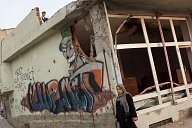
The uprising of the Kurds
Alexandre Afonso / Le Pictorium
LePictorium_0141237.jpg
The uprising of the Kurds: Diyarbakir and Nosaybin Kurds make up roughly one third out of Turkey's eighty million citizens. Though an almost absolute majority in the south-eastern provinces, they have hardly any rights and are faced with systemic discrimination that is coming to its tragic phase as testified in these images. Kurds have first tried political cooperation, the June elections for the first time brought a Kurdish party to the state parliament. This success and the possibility of a joint Turkish/Kurdish opposition as the Kurdish cause of political emancipation has rallied other minority and progressive votes inside the mainstream Turkish society frightenned the rulling AKP party, that before the repeated november elections – for they were unable to build a coalition- one sidedly ended the long ceasefire with the outlawed Workers party of Kurdistan (The PKK). Yet the Kurds were patient even during Ankara's unprovoked offensive, yet they succeeded in dividing the country among ethnic lines. After highly controversial elections that gave power to the AKP party, the Kurds were once again alone, if they could not strive for cooperation and a fairer Turkey, they should strive for autonomy. If the legal political activity of HDP party proved unsuccesfull, the initiative is once more on the PKK guerillas, if Turkey bombed the rural areas and mountain bases, the PKK resorted to a new tactic, trough their youth branches, they declared autonomy in certain urban centers, the heart of Kurdish community. Hope was that Turkey will be more lenient selective in attacking heavily populated areas as opposed to ruthlessly devastating the countryside far from any witnesses. This was not the case. Turkey responded with brutal force when attacking the guerillas seeking autonomy in their own community, aid workers are prohibited to access the wounded civilians caught in the crossfire, with dozens of dead each day. The official numbers are high enough yet they are impossible to determine as observers and journalists are denied access with threats of deportation or even physical harm while the locals who communicate with the press risk the possibility of a much more brutal consequences. The following photographs from Diyarbakir and Nosaybin, two of the seven cities that have districts under 24-hour curfews, cannot capture the conflict as one of the most oppressive regimes in history does everything in its power to make witnessing impossible. But the images do testify the conflict, as Ankara is using this conflict as an excuse for ethnic cleansing and general oppression of the Kurdish people. This is the only side that is accessible to the photojournalists. To make matters worse, most of the people in the photographs are forced to flee their homes for the second time in their lives. In the first uprising of the PKK in the nineties, Turkey used this as an excuse to empty the countryside, the cities in eastern Turkey tripled in size, now it's using the same excuse to reorganize the cities. The conflict is in its first phases yet its brutality is apparent, with reports of massacres by the government, mass deportations and general oppression in Turkish Kurdistan.
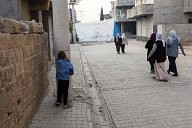
The uprising of the Kurds
Alexandre Afonso / Le Pictorium
LePictorium_0141238.jpg
The uprising of the Kurds: Diyarbakir and Nosaybin Kurds make up roughly one third out of Turkey's eighty million citizens. Though an almost absolute majority in the south-eastern provinces, they have hardly any rights and are faced with systemic discrimination that is coming to its tragic phase as testified in these images. Kurds have first tried political cooperation, the June elections for the first time brought a Kurdish party to the state parliament. This success and the possibility of a joint Turkish/Kurdish opposition as the Kurdish cause of political emancipation has rallied other minority and progressive votes inside the mainstream Turkish society frightenned the rulling AKP party, that before the repeated november elections – for they were unable to build a coalition- one sidedly ended the long ceasefire with the outlawed Workers party of Kurdistan (The PKK). Yet the Kurds were patient even during Ankara's unprovoked offensive, yet they succeeded in dividing the country among ethnic lines. After highly controversial elections that gave power to the AKP party, the Kurds were once again alone, if they could not strive for cooperation and a fairer Turkey, they should strive for autonomy. If the legal political activity of HDP party proved unsuccesfull, the initiative is once more on the PKK guerillas, if Turkey bombed the rural areas and mountain bases, the PKK resorted to a new tactic, trough their youth branches, they declared autonomy in certain urban centers, the heart of Kurdish community. Hope was that Turkey will be more lenient selective in attacking heavily populated areas as opposed to ruthlessly devastating the countryside far from any witnesses. This was not the case. Turkey responded with brutal force when attacking the guerillas seeking autonomy in their own community, aid workers are prohibited to access the wounded civilians caught in the crossfire, with dozens of dead each day. The official numbers are high enough yet they are impossible to determine as observers and journalists are denied access with threats of deportation or even physical harm while the locals who communicate with the press risk the possibility of a much more brutal consequences. The following photographs from Diyarbakir and Nosaybin, two of the seven cities that have districts under 24-hour curfews, cannot capture the conflict as one of the most oppressive regimes in history does everything in its power to make witnessing impossible. But the images do testify the conflict, as Ankara is using this conflict as an excuse for ethnic cleansing and general oppression of the Kurdish people. This is the only side that is accessible to the photojournalists. To make matters worse, most of the people in the photographs are forced to flee their homes for the second time in their lives. In the first uprising of the PKK in the nineties, Turkey used this as an excuse to empty the countryside, the cities in eastern Turkey tripled in size, now it's using the same excuse to reorganize the cities. The conflict is in its first phases yet its brutality is apparent, with reports of massacres by the government, mass deportations and general oppression in Turkish Kurdistan.
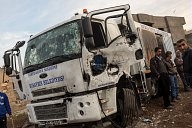
The uprising of the Kurds
Alexandre Afonso / Le Pictorium
LePictorium_0141239.jpg
The uprising of the Kurds: Diyarbakir and Nosaybin Kurds make up roughly one third out of Turkey's eighty million citizens. Though an almost absolute majority in the south-eastern provinces, they have hardly any rights and are faced with systemic discrimination that is coming to its tragic phase as testified in these images. Kurds have first tried political cooperation, the June elections for the first time brought a Kurdish party to the state parliament. This success and the possibility of a joint Turkish/Kurdish opposition as the Kurdish cause of political emancipation has rallied other minority and progressive votes inside the mainstream Turkish society frightenned the rulling AKP party, that before the repeated november elections – for they were unable to build a coalition- one sidedly ended the long ceasefire with the outlawed Workers party of Kurdistan (The PKK). Yet the Kurds were patient even during Ankara's unprovoked offensive, yet they succeeded in dividing the country among ethnic lines. After highly controversial elections that gave power to the AKP party, the Kurds were once again alone, if they could not strive for cooperation and a fairer Turkey, they should strive for autonomy. If the legal political activity of HDP party proved unsuccesfull, the initiative is once more on the PKK guerillas, if Turkey bombed the rural areas and mountain bases, the PKK resorted to a new tactic, trough their youth branches, they declared autonomy in certain urban centers, the heart of Kurdish community. Hope was that Turkey will be more lenient selective in attacking heavily populated areas as opposed to ruthlessly devastating the countryside far from any witnesses. This was not the case. Turkey responded with brutal force when attacking the guerillas seeking autonomy in their own community, aid workers are prohibited to access the wounded civilians caught in the crossfire, with dozens of dead each day. The official numbers are high enough yet they are impossible to determine as observers and journalists are denied access with threats of deportation or even physical harm while the locals who communicate with the press risk the possibility of a much more brutal consequences. The following photographs from Diyarbakir and Nosaybin, two of the seven cities that have districts under 24-hour curfews, cannot capture the conflict as one of the most oppressive regimes in history does everything in its power to make witnessing impossible. But the images do testify the conflict, as Ankara is using this conflict as an excuse for ethnic cleansing and general oppression of the Kurdish people. This is the only side that is accessible to the photojournalists. To make matters worse, most of the people in the photographs are forced to flee their homes for the second time in their lives. In the first uprising of the PKK in the nineties, Turkey used this as an excuse to empty the countryside, the cities in eastern Turkey tripled in size, now it's using the same excuse to reorganize the cities. The conflict is in its first phases yet its brutality is apparent, with reports of massacres by the government, mass deportations and general oppression in Turkish Kurdistan.
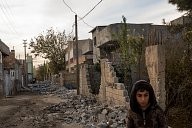
The uprising of the Kurds
Alexandre Afonso / Le Pictorium
LePictorium_0141240.jpg
The uprising of the Kurds: Diyarbakir and Nosaybin Kurds make up roughly one third out of Turkey's eighty million citizens. Though an almost absolute majority in the south-eastern provinces, they have hardly any rights and are faced with systemic discrimination that is coming to its tragic phase as testified in these images. Kurds have first tried political cooperation, the June elections for the first time brought a Kurdish party to the state parliament. This success and the possibility of a joint Turkish/Kurdish opposition as the Kurdish cause of political emancipation has rallied other minority and progressive votes inside the mainstream Turkish society frightenned the rulling AKP party, that before the repeated november elections – for they were unable to build a coalition- one sidedly ended the long ceasefire with the outlawed Workers party of Kurdistan (The PKK). Yet the Kurds were patient even during Ankara's unprovoked offensive, yet they succeeded in dividing the country among ethnic lines. After highly controversial elections that gave power to the AKP party, the Kurds were once again alone, if they could not strive for cooperation and a fairer Turkey, they should strive for autonomy. If the legal political activity of HDP party proved unsuccesfull, the initiative is once more on the PKK guerillas, if Turkey bombed the rural areas and mountain bases, the PKK resorted to a new tactic, trough their youth branches, they declared autonomy in certain urban centers, the heart of Kurdish community. Hope was that Turkey will be more lenient selective in attacking heavily populated areas as opposed to ruthlessly devastating the countryside far from any witnesses. This was not the case. Turkey responded with brutal force when attacking the guerillas seeking autonomy in their own community, aid workers are prohibited to access the wounded civilians caught in the crossfire, with dozens of dead each day. The official numbers are high enough yet they are impossible to determine as observers and journalists are denied access with threats of deportation or even physical harm while the locals who communicate with the press risk the possibility of a much more brutal consequences. The following photographs from Diyarbakir and Nosaybin, two of the seven cities that have districts under 24-hour curfews, cannot capture the conflict as one of the most oppressive regimes in history does everything in its power to make witnessing impossible. But the images do testify the conflict, as Ankara is using this conflict as an excuse for ethnic cleansing and general oppression of the Kurdish people. This is the only side that is accessible to the photojournalists. To make matters worse, most of the people in the photographs are forced to flee their homes for the second time in their lives. In the first uprising of the PKK in the nineties, Turkey used this as an excuse to empty the countryside, the cities in eastern Turkey tripled in size, now it's using the same excuse to reorganize the cities. The conflict is in its first phases yet its brutality is apparent, with reports of massacres by the government, mass deportations and general oppression in Turkish Kurdistan.
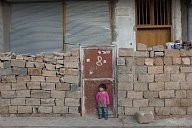
The uprising of the Kurds
Alexandre Afonso / Le Pictorium
LePictorium_0141241.jpg
The uprising of the Kurds: Diyarbakir and Nosaybin Kurds make up roughly one third out of Turkey's eighty million citizens. Though an almost absolute majority in the south-eastern provinces, they have hardly any rights and are faced with systemic discrimination that is coming to its tragic phase as testified in these images. Kurds have first tried political cooperation, the June elections for the first time brought a Kurdish party to the state parliament. This success and the possibility of a joint Turkish/Kurdish opposition as the Kurdish cause of political emancipation has rallied other minority and progressive votes inside the mainstream Turkish society frightenned the rulling AKP party, that before the repeated november elections – for they were unable to build a coalition- one sidedly ended the long ceasefire with the outlawed Workers party of Kurdistan (The PKK). Yet the Kurds were patient even during Ankara's unprovoked offensive, yet they succeeded in dividing the country among ethnic lines. After highly controversial elections that gave power to the AKP party, the Kurds were once again alone, if they could not strive for cooperation and a fairer Turkey, they should strive for autonomy. If the legal political activity of HDP party proved unsuccesfull, the initiative is once more on the PKK guerillas, if Turkey bombed the rural areas and mountain bases, the PKK resorted to a new tactic, trough their youth branches, they declared autonomy in certain urban centers, the heart of Kurdish community. Hope was that Turkey will be more lenient selective in attacking heavily populated areas as opposed to ruthlessly devastating the countryside far from any witnesses. This was not the case. Turkey responded with brutal force when attacking the guerillas seeking autonomy in their own community, aid workers are prohibited to access the wounded civilians caught in the crossfire, with dozens of dead each day. The official numbers are high enough yet they are impossible to determine as observers and journalists are denied access with threats of deportation or even physical harm while the locals who communicate with the press risk the possibility of a much more brutal consequences. The following photographs from Diyarbakir and Nosaybin, two of the seven cities that have districts under 24-hour curfews, cannot capture the conflict as one of the most oppressive regimes in history does everything in its power to make witnessing impossible. But the images do testify the conflict, as Ankara is using this conflict as an excuse for ethnic cleansing and general oppression of the Kurdish people. This is the only side that is accessible to the photojournalists. To make matters worse, most of the people in the photographs are forced to flee their homes for the second time in their lives. In the first uprising of the PKK in the nineties, Turkey used this as an excuse to empty the countryside, the cities in eastern Turkey tripled in size, now it's using the same excuse to reorganize the cities. The conflict is in its first phases yet its brutality is apparent, with reports of massacres by the government, mass deportations and general oppression in Turkish Kurdistan.
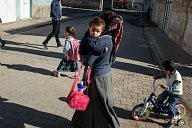
The uprising of the Kurds
Alexandre Afonso / Le Pictorium
LePictorium_0141242.jpg
The uprising of the Kurds: Diyarbakir and Nosaybin Kurds make up roughly one third out of Turkey's eighty million citizens. Though an almost absolute majority in the south-eastern provinces, they have hardly any rights and are faced with systemic discrimination that is coming to its tragic phase as testified in these images. Kurds have first tried political cooperation, the June elections for the first time brought a Kurdish party to the state parliament. This success and the possibility of a joint Turkish/Kurdish opposition as the Kurdish cause of political emancipation has rallied other minority and progressive votes inside the mainstream Turkish society frightenned the rulling AKP party, that before the repeated november elections – for they were unable to build a coalition- one sidedly ended the long ceasefire with the outlawed Workers party of Kurdistan (The PKK). Yet the Kurds were patient even during Ankara's unprovoked offensive, yet they succeeded in dividing the country among ethnic lines. After highly controversial elections that gave power to the AKP party, the Kurds were once again alone, if they could not strive for cooperation and a fairer Turkey, they should strive for autonomy. If the legal political activity of HDP party proved unsuccesfull, the initiative is once more on the PKK guerillas, if Turkey bombed the rural areas and mountain bases, the PKK resorted to a new tactic, trough their youth branches, they declared autonomy in certain urban centers, the heart of Kurdish community. Hope was that Turkey will be more lenient selective in attacking heavily populated areas as opposed to ruthlessly devastating the countryside far from any witnesses. This was not the case. Turkey responded with brutal force when attacking the guerillas seeking autonomy in their own community, aid workers are prohibited to access the wounded civilians caught in the crossfire, with dozens of dead each day. The official numbers are high enough yet they are impossible to determine as observers and journalists are denied access with threats of deportation or even physical harm while the locals who communicate with the press risk the possibility of a much more brutal consequences. The following photographs from Diyarbakir and Nosaybin, two of the seven cities that have districts under 24-hour curfews, cannot capture the conflict as one of the most oppressive regimes in history does everything in its power to make witnessing impossible. But the images do testify the conflict, as Ankara is using this conflict as an excuse for ethnic cleansing and general oppression of the Kurdish people. This is the only side that is accessible to the photojournalists. To make matters worse, most of the people in the photographs are forced to flee their homes for the second time in their lives. In the first uprising of the PKK in the nineties, Turkey used this as an excuse to empty the countryside, the cities in eastern Turkey tripled in size, now it's using the same excuse to reorganize the cities. The conflict is in its first phases yet its brutality is apparent, with reports of massacres by the government, mass deportations and general oppression in Turkish Kurdistan.
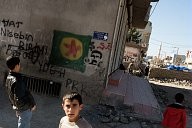
The uprising of the Kurds
Alexandre Afonso / Le Pictorium
LePictorium_0141243.jpg
The uprising of the Kurds: Diyarbakir and Nosaybin Kurds make up roughly one third out of Turkey's eighty million citizens. Though an almost absolute majority in the south-eastern provinces, they have hardly any rights and are faced with systemic discrimination that is coming to its tragic phase as testified in these images. Kurds have first tried political cooperation, the June elections for the first time brought a Kurdish party to the state parliament. This success and the possibility of a joint Turkish/Kurdish opposition as the Kurdish cause of political emancipation has rallied other minority and progressive votes inside the mainstream Turkish society frightenned the rulling AKP party, that before the repeated november elections – for they were unable to build a coalition- one sidedly ended the long ceasefire with the outlawed Workers party of Kurdistan (The PKK). Yet the Kurds were patient even during Ankara's unprovoked offensive, yet they succeeded in dividing the country among ethnic lines. After highly controversial elections that gave power to the AKP party, the Kurds were once again alone, if they could not strive for cooperation and a fairer Turkey, they should strive for autonomy. If the legal political activity of HDP party proved unsuccesfull, the initiative is once more on the PKK guerillas, if Turkey bombed the rural areas and mountain bases, the PKK resorted to a new tactic, trough their youth branches, they declared autonomy in certain urban centers, the heart of Kurdish community. Hope was that Turkey will be more lenient selective in attacking heavily populated areas as opposed to ruthlessly devastating the countryside far from any witnesses. This was not the case. Turkey responded with brutal force when attacking the guerillas seeking autonomy in their own community, aid workers are prohibited to access the wounded civilians caught in the crossfire, with dozens of dead each day. The official numbers are high enough yet they are impossible to determine as observers and journalists are denied access with threats of deportation or even physical harm while the locals who communicate with the press risk the possibility of a much more brutal consequences. The following photographs from Diyarbakir and Nosaybin, two of the seven cities that have districts under 24-hour curfews, cannot capture the conflict as one of the most oppressive regimes in history does everything in its power to make witnessing impossible. But the images do testify the conflict, as Ankara is using this conflict as an excuse for ethnic cleansing and general oppression of the Kurdish people. This is the only side that is accessible to the photojournalists. To make matters worse, most of the people in the photographs are forced to flee their homes for the second time in their lives. In the first uprising of the PKK in the nineties, Turkey used this as an excuse to empty the countryside, the cities in eastern Turkey tripled in size, now it's using the same excuse to reorganize the cities. The conflict is in its first phases yet its brutality is apparent, with reports of massacres by the government, mass deportations and general oppression in Turkish Kurdistan.
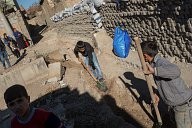
The uprising of the Kurds
Alexandre Afonso / Le Pictorium
LePictorium_0141244.jpg
The uprising of the Kurds: Diyarbakir and Nosaybin Kurds make up roughly one third out of Turkey's eighty million citizens. Though an almost absolute majority in the south-eastern provinces, they have hardly any rights and are faced with systemic discrimination that is coming to its tragic phase as testified in these images. Kurds have first tried political cooperation, the June elections for the first time brought a Kurdish party to the state parliament. This success and the possibility of a joint Turkish/Kurdish opposition as the Kurdish cause of political emancipation has rallied other minority and progressive votes inside the mainstream Turkish society frightenned the rulling AKP party, that before the repeated november elections – for they were unable to build a coalition- one sidedly ended the long ceasefire with the outlawed Workers party of Kurdistan (The PKK). Yet the Kurds were patient even during Ankara's unprovoked offensive, yet they succeeded in dividing the country among ethnic lines. After highly controversial elections that gave power to the AKP party, the Kurds were once again alone, if they could not strive for cooperation and a fairer Turkey, they should strive for autonomy. If the legal political activity of HDP party proved unsuccesfull, the initiative is once more on the PKK guerillas, if Turkey bombed the rural areas and mountain bases, the PKK resorted to a new tactic, trough their youth branches, they declared autonomy in certain urban centers, the heart of Kurdish community. Hope was that Turkey will be more lenient selective in attacking heavily populated areas as opposed to ruthlessly devastating the countryside far from any witnesses. This was not the case. Turkey responded with brutal force when attacking the guerillas seeking autonomy in their own community, aid workers are prohibited to access the wounded civilians caught in the crossfire, with dozens of dead each day. The official numbers are high enough yet they are impossible to determine as observers and journalists are denied access with threats of deportation or even physical harm while the locals who communicate with the press risk the possibility of a much more brutal consequences. The following photographs from Diyarbakir and Nosaybin, two of the seven cities that have districts under 24-hour curfews, cannot capture the conflict as one of the most oppressive regimes in history does everything in its power to make witnessing impossible. But the images do testify the conflict, as Ankara is using this conflict as an excuse for ethnic cleansing and general oppression of the Kurdish people. This is the only side that is accessible to the photojournalists. To make matters worse, most of the people in the photographs are forced to flee their homes for the second time in their lives. In the first uprising of the PKK in the nineties, Turkey used this as an excuse to empty the countryside, the cities in eastern Turkey tripled in size, now it's using the same excuse to reorganize the cities. The conflict is in its first phases yet its brutality is apparent, with reports of massacres by the government, mass deportations and general oppression in Turkish Kurdistan.
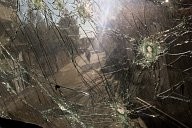
The uprising of the Kurds
Alexandre Afonso / Le Pictorium
LePictorium_0141245.jpg
The uprising of the Kurds: Diyarbakir and Nosaybin Kurds make up roughly one third out of Turkey's eighty million citizens. Though an almost absolute majority in the south-eastern provinces, they have hardly any rights and are faced with systemic discrimination that is coming to its tragic phase as testified in these images. Kurds have first tried political cooperation, the June elections for the first time brought a Kurdish party to the state parliament. This success and the possibility of a joint Turkish/Kurdish opposition as the Kurdish cause of political emancipation has rallied other minority and progressive votes inside the mainstream Turkish society frightenned the rulling AKP party, that before the repeated november elections – for they were unable to build a coalition- one sidedly ended the long ceasefire with the outlawed Workers party of Kurdistan (The PKK). Yet the Kurds were patient even during Ankara's unprovoked offensive, yet they succeeded in dividing the country among ethnic lines. After highly controversial elections that gave power to the AKP party, the Kurds were once again alone, if they could not strive for cooperation and a fairer Turkey, they should strive for autonomy. If the legal political activity of HDP party proved unsuccesfull, the initiative is once more on the PKK guerillas, if Turkey bombed the rural areas and mountain bases, the PKK resorted to a new tactic, trough their youth branches, they declared autonomy in certain urban centers, the heart of Kurdish community. Hope was that Turkey will be more lenient selective in attacking heavily populated areas as opposed to ruthlessly devastating the countryside far from any witnesses. This was not the case. Turkey responded with brutal force when attacking the guerillas seeking autonomy in their own community, aid workers are prohibited to access the wounded civilians caught in the crossfire, with dozens of dead each day. The official numbers are high enough yet they are impossible to determine as observers and journalists are denied access with threats of deportation or even physical harm while the locals who communicate with the press risk the possibility of a much more brutal consequences. The following photographs from Diyarbakir and Nosaybin, two of the seven cities that have districts under 24-hour curfews, cannot capture the conflict as one of the most oppressive regimes in history does everything in its power to make witnessing impossible. But the images do testify the conflict, as Ankara is using this conflict as an excuse for ethnic cleansing and general oppression of the Kurdish people. This is the only side that is accessible to the photojournalists. To make matters worse, most of the people in the photographs are forced to flee their homes for the second time in their lives. In the first uprising of the PKK in the nineties, Turkey used this as an excuse to empty the countryside, the cities in eastern Turkey tripled in size, now it's using the same excuse to reorganize the cities. The conflict is in its first phases yet its brutality is apparent, with reports of massacres by the government, mass deportations and general oppression in Turkish Kurdistan.

The uprising of the Kurds
Alexandre Afonso / Le Pictorium
LePictorium_0141246.jpg
The uprising of the Kurds: Diyarbakir and Nosaybin Kurds make up roughly one third out of Turkey's eighty million citizens. Though an almost absolute majority in the south-eastern provinces, they have hardly any rights and are faced with systemic discrimination that is coming to its tragic phase as testified in these images. Kurds have first tried political cooperation, the June elections for the first time brought a Kurdish party to the state parliament. This success and the possibility of a joint Turkish/Kurdish opposition as the Kurdish cause of political emancipation has rallied other minority and progressive votes inside the mainstream Turkish society frightenned the rulling AKP party, that before the repeated november elections – for they were unable to build a coalition- one sidedly ended the long ceasefire with the outlawed Workers party of Kurdistan (The PKK). Yet the Kurds were patient even during Ankara's unprovoked offensive, yet they succeeded in dividing the country among ethnic lines. After highly controversial elections that gave power to the AKP party, the Kurds were once again alone, if they could not strive for cooperation and a fairer Turkey, they should strive for autonomy. If the legal political activity of HDP party proved unsuccesfull, the initiative is once more on the PKK guerillas, if Turkey bombed the rural areas and mountain bases, the PKK resorted to a new tactic, trough their youth branches, they declared autonomy in certain urban centers, the heart of Kurdish community. Hope was that Turkey will be more lenient selective in attacking heavily populated areas as opposed to ruthlessly devastating the countryside far from any witnesses. This was not the case. Turkey responded with brutal force when attacking the guerillas seeking autonomy in their own community, aid workers are prohibited to access the wounded civilians caught in the crossfire, with dozens of dead each day. The official numbers are high enough yet they are impossible to determine as observers and journalists are denied access with threats of deportation or even physical harm while the locals who communicate with the press risk the possibility of a much more brutal consequences. The following photographs from Diyarbakir and Nosaybin, two of the seven cities that have districts under 24-hour curfews, cannot capture the conflict as one of the most oppressive regimes in history does everything in its power to make witnessing impossible. But the images do testify the conflict, as Ankara is using this conflict as an excuse for ethnic cleansing and general oppression of the Kurdish people. This is the only side that is accessible to the photojournalists. To make matters worse, most of the people in the photographs are forced to flee their homes for the second time in their lives. In the first uprising of the PKK in the nineties, Turkey used this as an excuse to empty the countryside, the cities in eastern Turkey tripled in size, now it's using the same excuse to reorganize the cities. The conflict is in its first phases yet its brutality is apparent, with reports of massacres by the government, mass deportations and general oppression in Turkish Kurdistan.
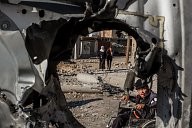
The uprising of the Kurds
Alexandre Afonso / Le Pictorium
LePictorium_0141247.jpg
The uprising of the Kurds: Diyarbakir and Nosaybin Kurds make up roughly one third out of Turkey's eighty million citizens. Though an almost absolute majority in the south-eastern provinces, they have hardly any rights and are faced with systemic discrimination that is coming to its tragic phase as testified in these images. Kurds have first tried political cooperation, the June elections for the first time brought a Kurdish party to the state parliament. This success and the possibility of a joint Turkish/Kurdish opposition as the Kurdish cause of political emancipation has rallied other minority and progressive votes inside the mainstream Turkish society frightenned the rulling AKP party, that before the repeated november elections – for they were unable to build a coalition- one sidedly ended the long ceasefire with the outlawed Workers party of Kurdistan (The PKK). Yet the Kurds were patient even during Ankara's unprovoked offensive, yet they succeeded in dividing the country among ethnic lines. After highly controversial elections that gave power to the AKP party, the Kurds were once again alone, if they could not strive for cooperation and a fairer Turkey, they should strive for autonomy. If the legal political activity of HDP party proved unsuccesfull, the initiative is once more on the PKK guerillas, if Turkey bombed the rural areas and mountain bases, the PKK resorted to a new tactic, trough their youth branches, they declared autonomy in certain urban centers, the heart of Kurdish community. Hope was that Turkey will be more lenient selective in attacking heavily populated areas as opposed to ruthlessly devastating the countryside far from any witnesses. This was not the case. Turkey responded with brutal force when attacking the guerillas seeking autonomy in their own community, aid workers are prohibited to access the wounded civilians caught in the crossfire, with dozens of dead each day. The official numbers are high enough yet they are impossible to determine as observers and journalists are denied access with threats of deportation or even physical harm while the locals who communicate with the press risk the possibility of a much more brutal consequences. The following photographs from Diyarbakir and Nosaybin, two of the seven cities that have districts under 24-hour curfews, cannot capture the conflict as one of the most oppressive regimes in history does everything in its power to make witnessing impossible. But the images do testify the conflict, as Ankara is using this conflict as an excuse for ethnic cleansing and general oppression of the Kurdish people. This is the only side that is accessible to the photojournalists. To make matters worse, most of the people in the photographs are forced to flee their homes for the second time in their lives. In the first uprising of the PKK in the nineties, Turkey used this as an excuse to empty the countryside, the cities in eastern Turkey tripled in size, now it's using the same excuse to reorganize the cities. The conflict is in its first phases yet its brutality is apparent, with reports of massacres by the government, mass deportations and general oppression in Turkish Kurdistan.
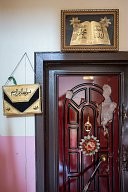
The uprising of the Kurds
Alexandre Afonso / Le Pictorium
LePictorium_0141248.jpg
The uprising of the Kurds: Diyarbakir and Nosaybin Kurds make up roughly one third out of Turkey's eighty million citizens. Though an almost absolute majority in the south-eastern provinces, they have hardly any rights and are faced with systemic discrimination that is coming to its tragic phase as testified in these images. Kurds have first tried political cooperation, the June elections for the first time brought a Kurdish party to the state parliament. This success and the possibility of a joint Turkish/Kurdish opposition as the Kurdish cause of political emancipation has rallied other minority and progressive votes inside the mainstream Turkish society frightenned the rulling AKP party, that before the repeated november elections – for they were unable to build a coalition- one sidedly ended the long ceasefire with the outlawed Workers party of Kurdistan (The PKK). Yet the Kurds were patient even during Ankara's unprovoked offensive, yet they succeeded in dividing the country among ethnic lines. After highly controversial elections that gave power to the AKP party, the Kurds were once again alone, if they could not strive for cooperation and a fairer Turkey, they should strive for autonomy. If the legal political activity of HDP party proved unsuccesfull, the initiative is once more on the PKK guerillas, if Turkey bombed the rural areas and mountain bases, the PKK resorted to a new tactic, trough their youth branches, they declared autonomy in certain urban centers, the heart of Kurdish community. Hope was that Turkey will be more lenient selective in attacking heavily populated areas as opposed to ruthlessly devastating the countryside far from any witnesses. This was not the case. Turkey responded with brutal force when attacking the guerillas seeking autonomy in their own community, aid workers are prohibited to access the wounded civilians caught in the crossfire, with dozens of dead each day. The official numbers are high enough yet they are impossible to determine as observers and journalists are denied access with threats of deportation or even physical harm while the locals who communicate with the press risk the possibility of a much more brutal consequences. The following photographs from Diyarbakir and Nosaybin, two of the seven cities that have districts under 24-hour curfews, cannot capture the conflict as one of the most oppressive regimes in history does everything in its power to make witnessing impossible. But the images do testify the conflict, as Ankara is using this conflict as an excuse for ethnic cleansing and general oppression of the Kurdish people. This is the only side that is accessible to the photojournalists. To make matters worse, most of the people in the photographs are forced to flee their homes for the second time in their lives. In the first uprising of the PKK in the nineties, Turkey used this as an excuse to empty the countryside, the cities in eastern Turkey tripled in size, now it's using the same excuse to reorganize the cities. The conflict is in its first phases yet its brutality is apparent, with reports of massacres by the government, mass deportations and general oppression in Turkish Kurdistan.
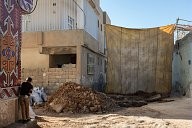
The uprising of the Kurds
Alexandre Afonso / Le Pictorium
LePictorium_0141249.jpg
The uprising of the Kurds: Diyarbakir and Nosaybin Kurds make up roughly one third out of Turkey's eighty million citizens. Though an almost absolute majority in the south-eastern provinces, they have hardly any rights and are faced with systemic discrimination that is coming to its tragic phase as testified in these images. Kurds have first tried political cooperation, the June elections for the first time brought a Kurdish party to the state parliament. This success and the possibility of a joint Turkish/Kurdish opposition as the Kurdish cause of political emancipation has rallied other minority and progressive votes inside the mainstream Turkish society frightenned the rulling AKP party, that before the repeated november elections – for they were unable to build a coalition- one sidedly ended the long ceasefire with the outlawed Workers party of Kurdistan (The PKK). Yet the Kurds were patient even during Ankara's unprovoked offensive, yet they succeeded in dividing the country among ethnic lines. After highly controversial elections that gave power to the AKP party, the Kurds were once again alone, if they could not strive for cooperation and a fairer Turkey, they should strive for autonomy. If the legal political activity of HDP party proved unsuccesfull, the initiative is once more on the PKK guerillas, if Turkey bombed the rural areas and mountain bases, the PKK resorted to a new tactic, trough their youth branches, they declared autonomy in certain urban centers, the heart of Kurdish community. Hope was that Turkey will be more lenient selective in attacking heavily populated areas as opposed to ruthlessly devastating the countryside far from any witnesses. This was not the case. Turkey responded with brutal force when attacking the guerillas seeking autonomy in their own community, aid workers are prohibited to access the wounded civilians caught in the crossfire, with dozens of dead each day. The official numbers are high enough yet they are impossible to determine as observers and journalists are denied access with threats of deportation or even physical harm while the locals who communicate with the press risk the possibility of a much more brutal consequences. The following photographs from Diyarbakir and Nosaybin, two of the seven cities that have districts under 24-hour curfews, cannot capture the conflict as one of the most oppressive regimes in history does everything in its power to make witnessing impossible. But the images do testify the conflict, as Ankara is using this conflict as an excuse for ethnic cleansing and general oppression of the Kurdish people. This is the only side that is accessible to the photojournalists. To make matters worse, most of the people in the photographs are forced to flee their homes for the second time in their lives. In the first uprising of the PKK in the nineties, Turkey used this as an excuse to empty the countryside, the cities in eastern Turkey tripled in size, now it's using the same excuse to reorganize the cities. The conflict is in its first phases yet its brutality is apparent, with reports of massacres by the government, mass deportations and general oppression in Turkish Kurdistan.
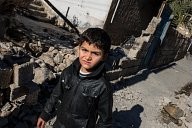
The uprising of the Kurds
Alexandre Afonso / Le Pictorium
LePictorium_0141250.jpg
The uprising of the Kurds: Diyarbakir and Nosaybin Kurds make up roughly one third out of Turkey's eighty million citizens. Though an almost absolute majority in the south-eastern provinces, they have hardly any rights and are faced with systemic discrimination that is coming to its tragic phase as testified in these images. Kurds have first tried political cooperation, the June elections for the first time brought a Kurdish party to the state parliament. This success and the possibility of a joint Turkish/Kurdish opposition as the Kurdish cause of political emancipation has rallied other minority and progressive votes inside the mainstream Turkish society frightenned the rulling AKP party, that before the repeated november elections – for they were unable to build a coalition- one sidedly ended the long ceasefire with the outlawed Workers party of Kurdistan (The PKK). Yet the Kurds were patient even during Ankara's unprovoked offensive, yet they succeeded in dividing the country among ethnic lines. After highly controversial elections that gave power to the AKP party, the Kurds were once again alone, if they could not strive for cooperation and a fairer Turkey, they should strive for autonomy. If the legal political activity of HDP party proved unsuccesfull, the initiative is once more on the PKK guerillas, if Turkey bombed the rural areas and mountain bases, the PKK resorted to a new tactic, trough their youth branches, they declared autonomy in certain urban centers, the heart of Kurdish community. Hope was that Turkey will be more lenient selective in attacking heavily populated areas as opposed to ruthlessly devastating the countryside far from any witnesses. This was not the case. Turkey responded with brutal force when attacking the guerillas seeking autonomy in their own community, aid workers are prohibited to access the wounded civilians caught in the crossfire, with dozens of dead each day. The official numbers are high enough yet they are impossible to determine as observers and journalists are denied access with threats of deportation or even physical harm while the locals who communicate with the press risk the possibility of a much more brutal consequences. The following photographs from Diyarbakir and Nosaybin, two of the seven cities that have districts under 24-hour curfews, cannot capture the conflict as one of the most oppressive regimes in history does everything in its power to make witnessing impossible. But the images do testify the conflict, as Ankara is using this conflict as an excuse for ethnic cleansing and general oppression of the Kurdish people. This is the only side that is accessible to the photojournalists. To make matters worse, most of the people in the photographs are forced to flee their homes for the second time in their lives. In the first uprising of the PKK in the nineties, Turkey used this as an excuse to empty the countryside, the cities in eastern Turkey tripled in size, now it's using the same excuse to reorganize the cities. The conflict is in its first phases yet its brutality is apparent, with reports of massacres by the government, mass deportations and general oppression in Turkish Kurdistan.
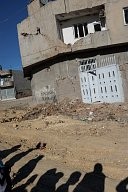
The uprising of the Kurds
Alexandre Afonso / Le Pictorium
LePictorium_0141251.jpg
The uprising of the Kurds: Diyarbakir and Nosaybin Kurds make up roughly one third out of Turkey's eighty million citizens. Though an almost absolute majority in the south-eastern provinces, they have hardly any rights and are faced with systemic discrimination that is coming to its tragic phase as testified in these images. Kurds have first tried political cooperation, the June elections for the first time brought a Kurdish party to the state parliament. This success and the possibility of a joint Turkish/Kurdish opposition as the Kurdish cause of political emancipation has rallied other minority and progressive votes inside the mainstream Turkish society frightenned the rulling AKP party, that before the repeated november elections – for they were unable to build a coalition- one sidedly ended the long ceasefire with the outlawed Workers party of Kurdistan (The PKK). Yet the Kurds were patient even during Ankara's unprovoked offensive, yet they succeeded in dividing the country among ethnic lines. After highly controversial elections that gave power to the AKP party, the Kurds were once again alone, if they could not strive for cooperation and a fairer Turkey, they should strive for autonomy. If the legal political activity of HDP party proved unsuccesfull, the initiative is once more on the PKK guerillas, if Turkey bombed the rural areas and mountain bases, the PKK resorted to a new tactic, trough their youth branches, they declared autonomy in certain urban centers, the heart of Kurdish community. Hope was that Turkey will be more lenient selective in attacking heavily populated areas as opposed to ruthlessly devastating the countryside far from any witnesses. This was not the case. Turkey responded with brutal force when attacking the guerillas seeking autonomy in their own community, aid workers are prohibited to access the wounded civilians caught in the crossfire, with dozens of dead each day. The official numbers are high enough yet they are impossible to determine as observers and journalists are denied access with threats of deportation or even physical harm while the locals who communicate with the press risk the possibility of a much more brutal consequences. The following photographs from Diyarbakir and Nosaybin, two of the seven cities that have districts under 24-hour curfews, cannot capture the conflict as one of the most oppressive regimes in history does everything in its power to make witnessing impossible. But the images do testify the conflict, as Ankara is using this conflict as an excuse for ethnic cleansing and general oppression of the Kurdish people. This is the only side that is accessible to the photojournalists. To make matters worse, most of the people in the photographs are forced to flee their homes for the second time in their lives. In the first uprising of the PKK in the nineties, Turkey used this as an excuse to empty the countryside, the cities in eastern Turkey tripled in size, now it's using the same excuse to reorganize the cities. The conflict is in its first phases yet its brutality is apparent, with reports of massacres by the government, mass deportations and general oppression in Turkish Kurdistan.
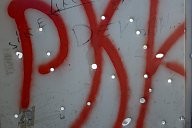
The uprising of the Kurds
Alexandre Afonso / Le Pictorium
LePictorium_0141252.jpg
The uprising of the Kurds: Diyarbakir and Nosaybin Kurds make up roughly one third out of Turkey's eighty million citizens. Though an almost absolute majority in the south-eastern provinces, they have hardly any rights and are faced with systemic discrimination that is coming to its tragic phase as testified in these images. Kurds have first tried political cooperation, the June elections for the first time brought a Kurdish party to the state parliament. This success and the possibility of a joint Turkish/Kurdish opposition as the Kurdish cause of political emancipation has rallied other minority and progressive votes inside the mainstream Turkish society frightenned the rulling AKP party, that before the repeated november elections – for they were unable to build a coalition- one sidedly ended the long ceasefire with the outlawed Workers party of Kurdistan (The PKK). Yet the Kurds were patient even during Ankara's unprovoked offensive, yet they succeeded in dividing the country among ethnic lines. After highly controversial elections that gave power to the AKP party, the Kurds were once again alone, if they could not strive for cooperation and a fairer Turkey, they should strive for autonomy. If the legal political activity of HDP party proved unsuccesfull, the initiative is once more on the PKK guerillas, if Turkey bombed the rural areas and mountain bases, the PKK resorted to a new tactic, trough their youth branches, they declared autonomy in certain urban centers, the heart of Kurdish community. Hope was that Turkey will be more lenient selective in attacking heavily populated areas as opposed to ruthlessly devastating the countryside far from any witnesses. This was not the case. Turkey responded with brutal force when attacking the guerillas seeking autonomy in their own community, aid workers are prohibited to access the wounded civilians caught in the crossfire, with dozens of dead each day. The official numbers are high enough yet they are impossible to determine as observers and journalists are denied access with threats of deportation or even physical harm while the locals who communicate with the press risk the possibility of a much more brutal consequences. The following photographs from Diyarbakir and Nosaybin, two of the seven cities that have districts under 24-hour curfews, cannot capture the conflict as one of the most oppressive regimes in history does everything in its power to make witnessing impossible. But the images do testify the conflict, as Ankara is using this conflict as an excuse for ethnic cleansing and general oppression of the Kurdish people. This is the only side that is accessible to the photojournalists. To make matters worse, most of the people in the photographs are forced to flee their homes for the second time in their lives. In the first uprising of the PKK in the nineties, Turkey used this as an excuse to empty the countryside, the cities in eastern Turkey tripled in size, now it's using the same excuse to reorganize the cities. The conflict is in its first phases yet its brutality is apparent, with reports of massacres by the government, mass deportations and general oppression in Turkish Kurdistan.

The uprising of the Kurds
Alexandre Afonso / Le Pictorium
LePictorium_0141253.jpg
The uprising of the Kurds: Diyarbakir and Nosaybin Kurds make up roughly one third out of Turkey's eighty million citizens. Though an almost absolute majority in the south-eastern provinces, they have hardly any rights and are faced with systemic discrimination that is coming to its tragic phase as testified in these images. Kurds have first tried political cooperation, the June elections for the first time brought a Kurdish party to the state parliament. This success and the possibility of a joint Turkish/Kurdish opposition as the Kurdish cause of political emancipation has rallied other minority and progressive votes inside the mainstream Turkish society frightenned the rulling AKP party, that before the repeated november elections – for they were unable to build a coalition- one sidedly ended the long ceasefire with the outlawed Workers party of Kurdistan (The PKK). Yet the Kurds were patient even during Ankara's unprovoked offensive, yet they succeeded in dividing the country among ethnic lines. After highly controversial elections that gave power to the AKP party, the Kurds were once again alone, if they could not strive for cooperation and a fairer Turkey, they should strive for autonomy. If the legal political activity of HDP party proved unsuccesfull, the initiative is once more on the PKK guerillas, if Turkey bombed the rural areas and mountain bases, the PKK resorted to a new tactic, trough their youth branches, they declared autonomy in certain urban centers, the heart of Kurdish community. Hope was that Turkey will be more lenient selective in attacking heavily populated areas as opposed to ruthlessly devastating the countryside far from any witnesses. This was not the case. Turkey responded with brutal force when attacking the guerillas seeking autonomy in their own community, aid workers are prohibited to access the wounded civilians caught in the crossfire, with dozens of dead each day. The official numbers are high enough yet they are impossible to determine as observers and journalists are denied access with threats of deportation or even physical harm while the locals who communicate with the press risk the possibility of a much more brutal consequences. The following photographs from Diyarbakir and Nosaybin, two of the seven cities that have districts under 24-hour curfews, cannot capture the conflict as one of the most oppressive regimes in history does everything in its power to make witnessing impossible. But the images do testify the conflict, as Ankara is using this conflict as an excuse for ethnic cleansing and general oppression of the Kurdish people. This is the only side that is accessible to the photojournalists. To make matters worse, most of the people in the photographs are forced to flee their homes for the second time in their lives. In the first uprising of the PKK in the nineties, Turkey used this as an excuse to empty the countryside, the cities in eastern Turkey tripled in size, now it's using the same excuse to reorganize the cities. The conflict is in its first phases yet its brutality is apparent, with reports of massacres by the government, mass deportations and general oppression in Turkish Kurdistan.
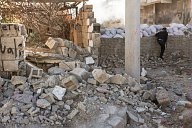
The uprising of the Kurds
Alexandre Afonso / Le Pictorium
LePictorium_0141254.jpg
The uprising of the Kurds: Diyarbakir and Nosaybin Kurds make up roughly one third out of Turkey's eighty million citizens. Though an almost absolute majority in the south-eastern provinces, they have hardly any rights and are faced with systemic discrimination that is coming to its tragic phase as testified in these images. Kurds have first tried political cooperation, the June elections for the first time brought a Kurdish party to the state parliament. This success and the possibility of a joint Turkish/Kurdish opposition as the Kurdish cause of political emancipation has rallied other minority and progressive votes inside the mainstream Turkish society frightenned the rulling AKP party, that before the repeated november elections – for they were unable to build a coalition- one sidedly ended the long ceasefire with the outlawed Workers party of Kurdistan (The PKK). Yet the Kurds were patient even during Ankara's unprovoked offensive, yet they succeeded in dividing the country among ethnic lines. After highly controversial elections that gave power to the AKP party, the Kurds were once again alone, if they could not strive for cooperation and a fairer Turkey, they should strive for autonomy. If the legal political activity of HDP party proved unsuccesfull, the initiative is once more on the PKK guerillas, if Turkey bombed the rural areas and mountain bases, the PKK resorted to a new tactic, trough their youth branches, they declared autonomy in certain urban centers, the heart of Kurdish community. Hope was that Turkey will be more lenient selective in attacking heavily populated areas as opposed to ruthlessly devastating the countryside far from any witnesses. This was not the case. Turkey responded with brutal force when attacking the guerillas seeking autonomy in their own community, aid workers are prohibited to access the wounded civilians caught in the crossfire, with dozens of dead each day. The official numbers are high enough yet they are impossible to determine as observers and journalists are denied access with threats of deportation or even physical harm while the locals who communicate with the press risk the possibility of a much more brutal consequences. The following photographs from Diyarbakir and Nosaybin, two of the seven cities that have districts under 24-hour curfews, cannot capture the conflict as one of the most oppressive regimes in history does everything in its power to make witnessing impossible. But the images do testify the conflict, as Ankara is using this conflict as an excuse for ethnic cleansing and general oppression of the Kurdish people. This is the only side that is accessible to the photojournalists. To make matters worse, most of the people in the photographs are forced to flee their homes for the second time in their lives. In the first uprising of the PKK in the nineties, Turkey used this as an excuse to empty the countryside, the cities in eastern Turkey tripled in size, now it's using the same excuse to reorganize the cities. The conflict is in its first phases yet its brutality is apparent, with reports of massacres by the government, mass deportations and general oppression in Turkish Kurdistan.
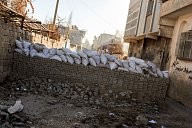
The uprising of the Kurds
Alexandre Afonso / Le Pictorium
LePictorium_0141255.jpg
The uprising of the Kurds: Diyarbakir and Nosaybin Kurds make up roughly one third out of Turkey's eighty million citizens. Though an almost absolute majority in the south-eastern provinces, they have hardly any rights and are faced with systemic discrimination that is coming to its tragic phase as testified in these images. Kurds have first tried political cooperation, the June elections for the first time brought a Kurdish party to the state parliament. This success and the possibility of a joint Turkish/Kurdish opposition as the Kurdish cause of political emancipation has rallied other minority and progressive votes inside the mainstream Turkish society frightenned the rulling AKP party, that before the repeated november elections – for they were unable to build a coalition- one sidedly ended the long ceasefire with the outlawed Workers party of Kurdistan (The PKK). Yet the Kurds were patient even during Ankara's unprovoked offensive, yet they succeeded in dividing the country among ethnic lines. After highly controversial elections that gave power to the AKP party, the Kurds were once again alone, if they could not strive for cooperation and a fairer Turkey, they should strive for autonomy. If the legal political activity of HDP party proved unsuccesfull, the initiative is once more on the PKK guerillas, if Turkey bombed the rural areas and mountain bases, the PKK resorted to a new tactic, trough their youth branches, they declared autonomy in certain urban centers, the heart of Kurdish community. Hope was that Turkey will be more lenient selective in attacking heavily populated areas as opposed to ruthlessly devastating the countryside far from any witnesses. This was not the case. Turkey responded with brutal force when attacking the guerillas seeking autonomy in their own community, aid workers are prohibited to access the wounded civilians caught in the crossfire, with dozens of dead each day. The official numbers are high enough yet they are impossible to determine as observers and journalists are denied access with threats of deportation or even physical harm while the locals who communicate with the press risk the possibility of a much more brutal consequences. The following photographs from Diyarbakir and Nosaybin, two of the seven cities that have districts under 24-hour curfews, cannot capture the conflict as one of the most oppressive regimes in history does everything in its power to make witnessing impossible. But the images do testify the conflict, as Ankara is using this conflict as an excuse for ethnic cleansing and general oppression of the Kurdish people. This is the only side that is accessible to the photojournalists. To make matters worse, most of the people in the photographs are forced to flee their homes for the second time in their lives. In the first uprising of the PKK in the nineties, Turkey used this as an excuse to empty the countryside, the cities in eastern Turkey tripled in size, now it's using the same excuse to reorganize the cities. The conflict is in its first phases yet its brutality is apparent, with reports of massacres by the government, mass deportations and general oppression in Turkish Kurdistan.
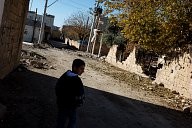
The uprising of the Kurds
Alexandre Afonso / Le Pictorium
LePictorium_0141257.jpg
The uprising of the Kurds: Diyarbakir and Nosaybin Kurds make up roughly one third out of Turkey's eighty million citizens. Though an almost absolute majority in the south-eastern provinces, they have hardly any rights and are faced with systemic discrimination that is coming to its tragic phase as testified in these images. Kurds have first tried political cooperation, the June elections for the first time brought a Kurdish party to the state parliament. This success and the possibility of a joint Turkish/Kurdish opposition as the Kurdish cause of political emancipation has rallied other minority and progressive votes inside the mainstream Turkish society frightenned the rulling AKP party, that before the repeated november elections – for they were unable to build a coalition- one sidedly ended the long ceasefire with the outlawed Workers party of Kurdistan (The PKK). Yet the Kurds were patient even during Ankara's unprovoked offensive, yet they succeeded in dividing the country among ethnic lines. After highly controversial elections that gave power to the AKP party, the Kurds were once again alone, if they could not strive for cooperation and a fairer Turkey, they should strive for autonomy. If the legal political activity of HDP party proved unsuccesfull, the initiative is once more on the PKK guerillas, if Turkey bombed the rural areas and mountain bases, the PKK resorted to a new tactic, trough their youth branches, they declared autonomy in certain urban centers, the heart of Kurdish community. Hope was that Turkey will be more lenient selective in attacking heavily populated areas as opposed to ruthlessly devastating the countryside far from any witnesses. This was not the case. Turkey responded with brutal force when attacking the guerillas seeking autonomy in their own community, aid workers are prohibited to access the wounded civilians caught in the crossfire, with dozens of dead each day. The official numbers are high enough yet they are impossible to determine as observers and journalists are denied access with threats of deportation or even physical harm while the locals who communicate with the press risk the possibility of a much more brutal consequences. The following photographs from Diyarbakir and Nosaybin, two of the seven cities that have districts under 24-hour curfews, cannot capture the conflict as one of the most oppressive regimes in history does everything in its power to make witnessing impossible. But the images do testify the conflict, as Ankara is using this conflict as an excuse for ethnic cleansing and general oppression of the Kurdish people. This is the only side that is accessible to the photojournalists. To make matters worse, most of the people in the photographs are forced to flee their homes for the second time in their lives. In the first uprising of the PKK in the nineties, Turkey used this as an excuse to empty the countryside, the cities in eastern Turkey tripled in size, now it's using the same excuse to reorganize the cities. The conflict is in its first phases yet its brutality is apparent, with reports of massacres by the government, mass deportations and general oppression in Turkish Kurdistan.
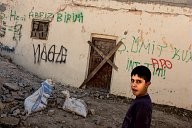
The uprising of the Kurds
Alexandre Afonso / Le Pictorium
LePictorium_0141258.jpg
The uprising of the Kurds: Diyarbakir and Nosaybin Kurds make up roughly one third out of Turkey's eighty million citizens. Though an almost absolute majority in the south-eastern provinces, they have hardly any rights and are faced with systemic discrimination that is coming to its tragic phase as testified in these images. Kurds have first tried political cooperation, the June elections for the first time brought a Kurdish party to the state parliament. This success and the possibility of a joint Turkish/Kurdish opposition as the Kurdish cause of political emancipation has rallied other minority and progressive votes inside the mainstream Turkish society frightenned the rulling AKP party, that before the repeated november elections – for they were unable to build a coalition- one sidedly ended the long ceasefire with the outlawed Workers party of Kurdistan (The PKK). Yet the Kurds were patient even during Ankara's unprovoked offensive, yet they succeeded in dividing the country among ethnic lines. After highly controversial elections that gave power to the AKP party, the Kurds were once again alone, if they could not strive for cooperation and a fairer Turkey, they should strive for autonomy. If the legal political activity of HDP party proved unsuccesfull, the initiative is once more on the PKK guerillas, if Turkey bombed the rural areas and mountain bases, the PKK resorted to a new tactic, trough their youth branches, they declared autonomy in certain urban centers, the heart of Kurdish community. Hope was that Turkey will be more lenient selective in attacking heavily populated areas as opposed to ruthlessly devastating the countryside far from any witnesses. This was not the case. Turkey responded with brutal force when attacking the guerillas seeking autonomy in their own community, aid workers are prohibited to access the wounded civilians caught in the crossfire, with dozens of dead each day. The official numbers are high enough yet they are impossible to determine as observers and journalists are denied access with threats of deportation or even physical harm while the locals who communicate with the press risk the possibility of a much more brutal consequences. The following photographs from Diyarbakir and Nosaybin, two of the seven cities that have districts under 24-hour curfews, cannot capture the conflict as one of the most oppressive regimes in history does everything in its power to make witnessing impossible. But the images do testify the conflict, as Ankara is using this conflict as an excuse for ethnic cleansing and general oppression of the Kurdish people. This is the only side that is accessible to the photojournalists. To make matters worse, most of the people in the photographs are forced to flee their homes for the second time in their lives. In the first uprising of the PKK in the nineties, Turkey used this as an excuse to empty the countryside, the cities in eastern Turkey tripled in size, now it's using the same excuse to reorganize the cities. The conflict is in its first phases yet its brutality is apparent, with reports of massacres by the government, mass deportations and general oppression in Turkish Kurdistan.
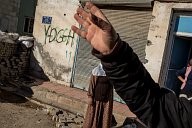
The uprising of the Kurds
Alexandre Afonso / Le Pictorium
LePictorium_0141259.jpg
The uprising of the Kurds: Diyarbakir and Nosaybin Kurds make up roughly one third out of Turkey's eighty million citizens. Though an almost absolute majority in the south-eastern provinces, they have hardly any rights and are faced with systemic discrimination that is coming to its tragic phase as testified in these images. Kurds have first tried political cooperation, the June elections for the first time brought a Kurdish party to the state parliament. This success and the possibility of a joint Turkish/Kurdish opposition as the Kurdish cause of political emancipation has rallied other minority and progressive votes inside the mainstream Turkish society frightenned the rulling AKP party, that before the repeated november elections – for they were unable to build a coalition- one sidedly ended the long ceasefire with the outlawed Workers party of Kurdistan (The PKK). Yet the Kurds were patient even during Ankara's unprovoked offensive, yet they succeeded in dividing the country among ethnic lines. After highly controversial elections that gave power to the AKP party, the Kurds were once again alone, if they could not strive for cooperation and a fairer Turkey, they should strive for autonomy. If the legal political activity of HDP party proved unsuccesfull, the initiative is once more on the PKK guerillas, if Turkey bombed the rural areas and mountain bases, the PKK resorted to a new tactic, trough their youth branches, they declared autonomy in certain urban centers, the heart of Kurdish community. Hope was that Turkey will be more lenient selective in attacking heavily populated areas as opposed to ruthlessly devastating the countryside far from any witnesses. This was not the case. Turkey responded with brutal force when attacking the guerillas seeking autonomy in their own community, aid workers are prohibited to access the wounded civilians caught in the crossfire, with dozens of dead each day. The official numbers are high enough yet they are impossible to determine as observers and journalists are denied access with threats of deportation or even physical harm while the locals who communicate with the press risk the possibility of a much more brutal consequences. The following photographs from Diyarbakir and Nosaybin, two of the seven cities that have districts under 24-hour curfews, cannot capture the conflict as one of the most oppressive regimes in history does everything in its power to make witnessing impossible. But the images do testify the conflict, as Ankara is using this conflict as an excuse for ethnic cleansing and general oppression of the Kurdish people. This is the only side that is accessible to the photojournalists. To make matters worse, most of the people in the photographs are forced to flee their homes for the second time in their lives. In the first uprising of the PKK in the nineties, Turkey used this as an excuse to empty the countryside, the cities in eastern Turkey tripled in size, now it's using the same excuse to reorganize the cities. The conflict is in its first phases yet its brutality is apparent, with reports of massacres by the government, mass deportations and general oppression in Turkish Kurdistan.
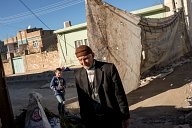
The uprising of the Kurds
Alexandre Afonso / Le Pictorium
LePictorium_0141260.jpg
The uprising of the Kurds: Diyarbakir and Nosaybin Kurds make up roughly one third out of Turkey's eighty million citizens. Though an almost absolute majority in the south-eastern provinces, they have hardly any rights and are faced with systemic discrimination that is coming to its tragic phase as testified in these images. Kurds have first tried political cooperation, the June elections for the first time brought a Kurdish party to the state parliament. This success and the possibility of a joint Turkish/Kurdish opposition as the Kurdish cause of political emancipation has rallied other minority and progressive votes inside the mainstream Turkish society frightenned the rulling AKP party, that before the repeated november elections – for they were unable to build a coalition- one sidedly ended the long ceasefire with the outlawed Workers party of Kurdistan (The PKK). Yet the Kurds were patient even during Ankara's unprovoked offensive, yet they succeeded in dividing the country among ethnic lines. After highly controversial elections that gave power to the AKP party, the Kurds were once again alone, if they could not strive for cooperation and a fairer Turkey, they should strive for autonomy. If the legal political activity of HDP party proved unsuccesfull, the initiative is once more on the PKK guerillas, if Turkey bombed the rural areas and mountain bases, the PKK resorted to a new tactic, trough their youth branches, they declared autonomy in certain urban centers, the heart of Kurdish community. Hope was that Turkey will be more lenient selective in attacking heavily populated areas as opposed to ruthlessly devastating the countryside far from any witnesses. This was not the case. Turkey responded with brutal force when attacking the guerillas seeking autonomy in their own community, aid workers are prohibited to access the wounded civilians caught in the crossfire, with dozens of dead each day. The official numbers are high enough yet they are impossible to determine as observers and journalists are denied access with threats of deportation or even physical harm while the locals who communicate with the press risk the possibility of a much more brutal consequences. The following photographs from Diyarbakir and Nosaybin, two of the seven cities that have districts under 24-hour curfews, cannot capture the conflict as one of the most oppressive regimes in history does everything in its power to make witnessing impossible. But the images do testify the conflict, as Ankara is using this conflict as an excuse for ethnic cleansing and general oppression of the Kurdish people. This is the only side that is accessible to the photojournalists. To make matters worse, most of the people in the photographs are forced to flee their homes for the second time in their lives. In the first uprising of the PKK in the nineties, Turkey used this as an excuse to empty the countryside, the cities in eastern Turkey tripled in size, now it's using the same excuse to reorganize the cities. The conflict is in its first phases yet its brutality is apparent, with reports of massacres by the government, mass deportations and general oppression in Turkish Kurdistan.
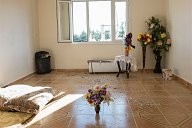
The uprising of the Kurds
Alexandre Afonso / Le Pictorium
LePictorium_0141261.jpg
The uprising of the Kurds: Diyarbakir and Nosaybin Kurds make up roughly one third out of Turkey's eighty million citizens. Though an almost absolute majority in the south-eastern provinces, they have hardly any rights and are faced with systemic discrimination that is coming to its tragic phase as testified in these images. Kurds have first tried political cooperation, the June elections for the first time brought a Kurdish party to the state parliament. This success and the possibility of a joint Turkish/Kurdish opposition as the Kurdish cause of political emancipation has rallied other minority and progressive votes inside the mainstream Turkish society frightenned the rulling AKP party, that before the repeated november elections – for they were unable to build a coalition- one sidedly ended the long ceasefire with the outlawed Workers party of Kurdistan (The PKK). Yet the Kurds were patient even during Ankara's unprovoked offensive, yet they succeeded in dividing the country among ethnic lines. After highly controversial elections that gave power to the AKP party, the Kurds were once again alone, if they could not strive for cooperation and a fairer Turkey, they should strive for autonomy. If the legal political activity of HDP party proved unsuccesfull, the initiative is once more on the PKK guerillas, if Turkey bombed the rural areas and mountain bases, the PKK resorted to a new tactic, trough their youth branches, they declared autonomy in certain urban centers, the heart of Kurdish community. Hope was that Turkey will be more lenient selective in attacking heavily populated areas as opposed to ruthlessly devastating the countryside far from any witnesses. This was not the case. Turkey responded with brutal force when attacking the guerillas seeking autonomy in their own community, aid workers are prohibited to access the wounded civilians caught in the crossfire, with dozens of dead each day. The official numbers are high enough yet they are impossible to determine as observers and journalists are denied access with threats of deportation or even physical harm while the locals who communicate with the press risk the possibility of a much more brutal consequences. The following photographs from Diyarbakir and Nosaybin, two of the seven cities that have districts under 24-hour curfews, cannot capture the conflict as one of the most oppressive regimes in history does everything in its power to make witnessing impossible. But the images do testify the conflict, as Ankara is using this conflict as an excuse for ethnic cleansing and general oppression of the Kurdish people. This is the only side that is accessible to the photojournalists. To make matters worse, most of the people in the photographs are forced to flee their homes for the second time in their lives. In the first uprising of the PKK in the nineties, Turkey used this as an excuse to empty the countryside, the cities in eastern Turkey tripled in size, now it's using the same excuse to reorganize the cities. The conflict is in its first phases yet its brutality is apparent, with reports of massacres by the government, mass deportations and general oppression in Turkish Kurdistan.

The uprising of the Kurds
Alexandre Afonso / Le Pictorium
LePictorium_0141262.jpg
The uprising of the Kurds: Diyarbakir and Nosaybin Kurds make up roughly one third out of Turkey's eighty million citizens. Though an almost absolute majority in the south-eastern provinces, they have hardly any rights and are faced with systemic discrimination that is coming to its tragic phase as testified in these images. Kurds have first tried political cooperation, the June elections for the first time brought a Kurdish party to the state parliament. This success and the possibility of a joint Turkish/Kurdish opposition as the Kurdish cause of political emancipation has rallied other minority and progressive votes inside the mainstream Turkish society frightenned the rulling AKP party, that before the repeated november elections – for they were unable to build a coalition- one sidedly ended the long ceasefire with the outlawed Workers party of Kurdistan (The PKK). Yet the Kurds were patient even during Ankara's unprovoked offensive, yet they succeeded in dividing the country among ethnic lines. After highly controversial elections that gave power to the AKP party, the Kurds were once again alone, if they could not strive for cooperation and a fairer Turkey, they should strive for autonomy. If the legal political activity of HDP party proved unsuccesfull, the initiative is once more on the PKK guerillas, if Turkey bombed the rural areas and mountain bases, the PKK resorted to a new tactic, trough their youth branches, they declared autonomy in certain urban centers, the heart of Kurdish community. Hope was that Turkey will be more lenient selective in attacking heavily populated areas as opposed to ruthlessly devastating the countryside far from any witnesses. This was not the case. Turkey responded with brutal force when attacking the guerillas seeking autonomy in their own community, aid workers are prohibited to access the wounded civilians caught in the crossfire, with dozens of dead each day. The official numbers are high enough yet they are impossible to determine as observers and journalists are denied access with threats of deportation or even physical harm while the locals who communicate with the press risk the possibility of a much more brutal consequences. The following photographs from Diyarbakir and Nosaybin, two of the seven cities that have districts under 24-hour curfews, cannot capture the conflict as one of the most oppressive regimes in history does everything in its power to make witnessing impossible. But the images do testify the conflict, as Ankara is using this conflict as an excuse for ethnic cleansing and general oppression of the Kurdish people. This is the only side that is accessible to the photojournalists. To make matters worse, most of the people in the photographs are forced to flee their homes for the second time in their lives. In the first uprising of the PKK in the nineties, Turkey used this as an excuse to empty the countryside, the cities in eastern Turkey tripled in size, now it's using the same excuse to reorganize the cities. The conflict is in its first phases yet its brutality is apparent, with reports of massacres by the government, mass deportations and general oppression in Turkish Kurdistan.
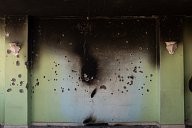
The uprising of the Kurds
Alexandre Afonso / Le Pictorium
LePictorium_0141263.jpg
The uprising of the Kurds: Diyarbakir and Nosaybin Kurds make up roughly one third out of Turkey's eighty million citizens. Though an almost absolute majority in the south-eastern provinces, they have hardly any rights and are faced with systemic discrimination that is coming to its tragic phase as testified in these images. Kurds have first tried political cooperation, the June elections for the first time brought a Kurdish party to the state parliament. This success and the possibility of a joint Turkish/Kurdish opposition as the Kurdish cause of political emancipation has rallied other minority and progressive votes inside the mainstream Turkish society frightenned the rulling AKP party, that before the repeated november elections – for they were unable to build a coalition- one sidedly ended the long ceasefire with the outlawed Workers party of Kurdistan (The PKK). Yet the Kurds were patient even during Ankara's unprovoked offensive, yet they succeeded in dividing the country among ethnic lines. After highly controversial elections that gave power to the AKP party, the Kurds were once again alone, if they could not strive for cooperation and a fairer Turkey, they should strive for autonomy. If the legal political activity of HDP party proved unsuccesfull, the initiative is once more on the PKK guerillas, if Turkey bombed the rural areas and mountain bases, the PKK resorted to a new tactic, trough their youth branches, they declared autonomy in certain urban centers, the heart of Kurdish community. Hope was that Turkey will be more lenient selective in attacking heavily populated areas as opposed to ruthlessly devastating the countryside far from any witnesses. This was not the case. Turkey responded with brutal force when attacking the guerillas seeking autonomy in their own community, aid workers are prohibited to access the wounded civilians caught in the crossfire, with dozens of dead each day. The official numbers are high enough yet they are impossible to determine as observers and journalists are denied access with threats of deportation or even physical harm while the locals who communicate with the press risk the possibility of a much more brutal consequences. The following photographs from Diyarbakir and Nosaybin, two of the seven cities that have districts under 24-hour curfews, cannot capture the conflict as one of the most oppressive regimes in history does everything in its power to make witnessing impossible. But the images do testify the conflict, as Ankara is using this conflict as an excuse for ethnic cleansing and general oppression of the Kurdish people. This is the only side that is accessible to the photojournalists. To make matters worse, most of the people in the photographs are forced to flee their homes for the second time in their lives. In the first uprising of the PKK in the nineties, Turkey used this as an excuse to empty the countryside, the cities in eastern Turkey tripled in size, now it's using the same excuse to reorganize the cities. The conflict is in its first phases yet its brutality is apparent, with reports of massacres by the government, mass deportations and general oppression in Turkish Kurdistan.
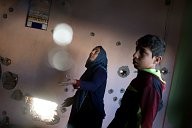
The uprising of the Kurds
Alexandre Afonso / Le Pictorium
LePictorium_0141264.jpg
The uprising of the Kurds: Diyarbakir and Nosaybin Kurds make up roughly one third out of Turkey's eighty million citizens. Though an almost absolute majority in the south-eastern provinces, they have hardly any rights and are faced with systemic discrimination that is coming to its tragic phase as testified in these images. Kurds have first tried political cooperation, the June elections for the first time brought a Kurdish party to the state parliament. This success and the possibility of a joint Turkish/Kurdish opposition as the Kurdish cause of political emancipation has rallied other minority and progressive votes inside the mainstream Turkish society frightenned the rulling AKP party, that before the repeated november elections – for they were unable to build a coalition- one sidedly ended the long ceasefire with the outlawed Workers party of Kurdistan (The PKK). Yet the Kurds were patient even during Ankara's unprovoked offensive, yet they succeeded in dividing the country among ethnic lines. After highly controversial elections that gave power to the AKP party, the Kurds were once again alone, if they could not strive for cooperation and a fairer Turkey, they should strive for autonomy. If the legal political activity of HDP party proved unsuccesfull, the initiative is once more on the PKK guerillas, if Turkey bombed the rural areas and mountain bases, the PKK resorted to a new tactic, trough their youth branches, they declared autonomy in certain urban centers, the heart of Kurdish community. Hope was that Turkey will be more lenient selective in attacking heavily populated areas as opposed to ruthlessly devastating the countryside far from any witnesses. This was not the case. Turkey responded with brutal force when attacking the guerillas seeking autonomy in their own community, aid workers are prohibited to access the wounded civilians caught in the crossfire, with dozens of dead each day. The official numbers are high enough yet they are impossible to determine as observers and journalists are denied access with threats of deportation or even physical harm while the locals who communicate with the press risk the possibility of a much more brutal consequences. The following photographs from Diyarbakir and Nosaybin, two of the seven cities that have districts under 24-hour curfews, cannot capture the conflict as one of the most oppressive regimes in history does everything in its power to make witnessing impossible. But the images do testify the conflict, as Ankara is using this conflict as an excuse for ethnic cleansing and general oppression of the Kurdish people. This is the only side that is accessible to the photojournalists. To make matters worse, most of the people in the photographs are forced to flee their homes for the second time in their lives. In the first uprising of the PKK in the nineties, Turkey used this as an excuse to empty the countryside, the cities in eastern Turkey tripled in size, now it's using the same excuse to reorganize the cities. The conflict is in its first phases yet its brutality is apparent, with reports of massacres by the government, mass deportations and general oppression in Turkish Kurdistan.
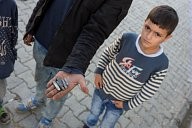
The uprising of the Kurds
Alexandre Afonso / Le Pictorium
LePictorium_0141265.jpg
The uprising of the Kurds: Diyarbakir and Nosaybin Kurds make up roughly one third out of Turkey's eighty million citizens. Though an almost absolute majority in the south-eastern provinces, they have hardly any rights and are faced with systemic discrimination that is coming to its tragic phase as testified in these images. Kurds have first tried political cooperation, the June elections for the first time brought a Kurdish party to the state parliament. This success and the possibility of a joint Turkish/Kurdish opposition as the Kurdish cause of political emancipation has rallied other minority and progressive votes inside the mainstream Turkish society frightenned the rulling AKP party, that before the repeated november elections – for they were unable to build a coalition- one sidedly ended the long ceasefire with the outlawed Workers party of Kurdistan (The PKK). Yet the Kurds were patient even during Ankara's unprovoked offensive, yet they succeeded in dividing the country among ethnic lines. After highly controversial elections that gave power to the AKP party, the Kurds were once again alone, if they could not strive for cooperation and a fairer Turkey, they should strive for autonomy. If the legal political activity of HDP party proved unsuccesfull, the initiative is once more on the PKK guerillas, if Turkey bombed the rural areas and mountain bases, the PKK resorted to a new tactic, trough their youth branches, they declared autonomy in certain urban centers, the heart of Kurdish community. Hope was that Turkey will be more lenient selective in attacking heavily populated areas as opposed to ruthlessly devastating the countryside far from any witnesses. This was not the case. Turkey responded with brutal force when attacking the guerillas seeking autonomy in their own community, aid workers are prohibited to access the wounded civilians caught in the crossfire, with dozens of dead each day. The official numbers are high enough yet they are impossible to determine as observers and journalists are denied access with threats of deportation or even physical harm while the locals who communicate with the press risk the possibility of a much more brutal consequences. The following photographs from Diyarbakir and Nosaybin, two of the seven cities that have districts under 24-hour curfews, cannot capture the conflict as one of the most oppressive regimes in history does everything in its power to make witnessing impossible. But the images do testify the conflict, as Ankara is using this conflict as an excuse for ethnic cleansing and general oppression of the Kurdish people. This is the only side that is accessible to the photojournalists. To make matters worse, most of the people in the photographs are forced to flee their homes for the second time in their lives. In the first uprising of the PKK in the nineties, Turkey used this as an excuse to empty the countryside, the cities in eastern Turkey tripled in size, now it's using the same excuse to reorganize the cities. The conflict is in its first phases yet its brutality is apparent, with reports of massacres by the government, mass deportations and general oppression in Turkish Kurdistan.
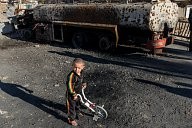
The uprising of the Kurds
Alexandre Afonso / Le Pictorium
LePictorium_0141266.jpg
The uprising of the Kurds: Diyarbakir and Nosaybin Kurds make up roughly one third out of Turkey's eighty million citizens. Though an almost absolute majority in the south-eastern provinces, they have hardly any rights and are faced with systemic discrimination that is coming to its tragic phase as testified in these images. Kurds have first tried political cooperation, the June elections for the first time brought a Kurdish party to the state parliament. This success and the possibility of a joint Turkish/Kurdish opposition as the Kurdish cause of political emancipation has rallied other minority and progressive votes inside the mainstream Turkish society frightenned the rulling AKP party, that before the repeated november elections – for they were unable to build a coalition- one sidedly ended the long ceasefire with the outlawed Workers party of Kurdistan (The PKK). Yet the Kurds were patient even during Ankara's unprovoked offensive, yet they succeeded in dividing the country among ethnic lines. After highly controversial elections that gave power to the AKP party, the Kurds were once again alone, if they could not strive for cooperation and a fairer Turkey, they should strive for autonomy. If the legal political activity of HDP party proved unsuccesfull, the initiative is once more on the PKK guerillas, if Turkey bombed the rural areas and mountain bases, the PKK resorted to a new tactic, trough their youth branches, they declared autonomy in certain urban centers, the heart of Kurdish community. Hope was that Turkey will be more lenient selective in attacking heavily populated areas as opposed to ruthlessly devastating the countryside far from any witnesses. This was not the case. Turkey responded with brutal force when attacking the guerillas seeking autonomy in their own community, aid workers are prohibited to access the wounded civilians caught in the crossfire, with dozens of dead each day. The official numbers are high enough yet they are impossible to determine as observers and journalists are denied access with threats of deportation or even physical harm while the locals who communicate with the press risk the possibility of a much more brutal consequences. The following photographs from Diyarbakir and Nosaybin, two of the seven cities that have districts under 24-hour curfews, cannot capture the conflict as one of the most oppressive regimes in history does everything in its power to make witnessing impossible. But the images do testify the conflict, as Ankara is using this conflict as an excuse for ethnic cleansing and general oppression of the Kurdish people. This is the only side that is accessible to the photojournalists. To make matters worse, most of the people in the photographs are forced to flee their homes for the second time in their lives. In the first uprising of the PKK in the nineties, Turkey used this as an excuse to empty the countryside, the cities in eastern Turkey tripled in size, now it's using the same excuse to reorganize the cities. The conflict is in its first phases yet its brutality is apparent, with reports of massacres by the government, mass deportations and general oppression in Turkish Kurdistan.
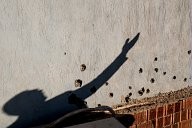
The uprising of the Kurds
Alexandre Afonso / Le Pictorium
LePictorium_0141267.jpg
The uprising of the Kurds: Diyarbakir and Nosaybin Kurds make up roughly one third out of Turkey's eighty million citizens. Though an almost absolute majority in the south-eastern provinces, they have hardly any rights and are faced with systemic discrimination that is coming to its tragic phase as testified in these images. Kurds have first tried political cooperation, the June elections for the first time brought a Kurdish party to the state parliament. This success and the possibility of a joint Turkish/Kurdish opposition as the Kurdish cause of political emancipation has rallied other minority and progressive votes inside the mainstream Turkish society frightenned the rulling AKP party, that before the repeated november elections – for they were unable to build a coalition- one sidedly ended the long ceasefire with the outlawed Workers party of Kurdistan (The PKK). Yet the Kurds were patient even during Ankara's unprovoked offensive, yet they succeeded in dividing the country among ethnic lines. After highly controversial elections that gave power to the AKP party, the Kurds were once again alone, if they could not strive for cooperation and a fairer Turkey, they should strive for autonomy. If the legal political activity of HDP party proved unsuccesfull, the initiative is once more on the PKK guerillas, if Turkey bombed the rural areas and mountain bases, the PKK resorted to a new tactic, trough their youth branches, they declared autonomy in certain urban centers, the heart of Kurdish community. Hope was that Turkey will be more lenient selective in attacking heavily populated areas as opposed to ruthlessly devastating the countryside far from any witnesses. This was not the case. Turkey responded with brutal force when attacking the guerillas seeking autonomy in their own community, aid workers are prohibited to access the wounded civilians caught in the crossfire, with dozens of dead each day. The official numbers are high enough yet they are impossible to determine as observers and journalists are denied access with threats of deportation or even physical harm while the locals who communicate with the press risk the possibility of a much more brutal consequences. The following photographs from Diyarbakir and Nosaybin, two of the seven cities that have districts under 24-hour curfews, cannot capture the conflict as one of the most oppressive regimes in history does everything in its power to make witnessing impossible. But the images do testify the conflict, as Ankara is using this conflict as an excuse for ethnic cleansing and general oppression of the Kurdish people. This is the only side that is accessible to the photojournalists. To make matters worse, most of the people in the photographs are forced to flee their homes for the second time in their lives. In the first uprising of the PKK in the nineties, Turkey used this as an excuse to empty the countryside, the cities in eastern Turkey tripled in size, now it's using the same excuse to reorganize the cities. The conflict is in its first phases yet its brutality is apparent, with reports of massacres by the government, mass deportations and general oppression in Turkish Kurdistan.
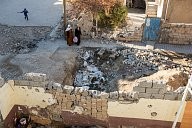
The uprising of the Kurds
Alexandre Afonso / Le Pictorium
LePictorium_0141268.jpg
The uprising of the Kurds: Diyarbakir and Nosaybin Kurds make up roughly one third out of Turkey's eighty million citizens. Though an almost absolute majority in the south-eastern provinces, they have hardly any rights and are faced with systemic discrimination that is coming to its tragic phase as testified in these images. Kurds have first tried political cooperation, the June elections for the first time brought a Kurdish party to the state parliament. This success and the possibility of a joint Turkish/Kurdish opposition as the Kurdish cause of political emancipation has rallied other minority and progressive votes inside the mainstream Turkish society frightenned the rulling AKP party, that before the repeated november elections – for they were unable to build a coalition- one sidedly ended the long ceasefire with the outlawed Workers party of Kurdistan (The PKK). Yet the Kurds were patient even during Ankara's unprovoked offensive, yet they succeeded in dividing the country among ethnic lines. After highly controversial elections that gave power to the AKP party, the Kurds were once again alone, if they could not strive for cooperation and a fairer Turkey, they should strive for autonomy. If the legal political activity of HDP party proved unsuccesfull, the initiative is once more on the PKK guerillas, if Turkey bombed the rural areas and mountain bases, the PKK resorted to a new tactic, trough their youth branches, they declared autonomy in certain urban centers, the heart of Kurdish community. Hope was that Turkey will be more lenient selective in attacking heavily populated areas as opposed to ruthlessly devastating the countryside far from any witnesses. This was not the case. Turkey responded with brutal force when attacking the guerillas seeking autonomy in their own community, aid workers are prohibited to access the wounded civilians caught in the crossfire, with dozens of dead each day. The official numbers are high enough yet they are impossible to determine as observers and journalists are denied access with threats of deportation or even physical harm while the locals who communicate with the press risk the possibility of a much more brutal consequences. The following photographs from Diyarbakir and Nosaybin, two of the seven cities that have districts under 24-hour curfews, cannot capture the conflict as one of the most oppressive regimes in history does everything in its power to make witnessing impossible. But the images do testify the conflict, as Ankara is using this conflict as an excuse for ethnic cleansing and general oppression of the Kurdish people. This is the only side that is accessible to the photojournalists. To make matters worse, most of the people in the photographs are forced to flee their homes for the second time in their lives. In the first uprising of the PKK in the nineties, Turkey used this as an excuse to empty the countryside, the cities in eastern Turkey tripled in size, now it's using the same excuse to reorganize the cities. The conflict is in its first phases yet its brutality is apparent, with reports of massacres by the government, mass deportations and general oppression in Turkish Kurdistan.
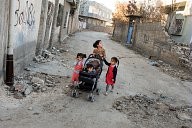
The uprising of the Kurds
Alexandre Afonso / Le Pictorium
LePictorium_0141269.jpg
The uprising of the Kurds: Diyarbakir and Nosaybin Kurds make up roughly one third out of Turkey's eighty million citizens. Though an almost absolute majority in the south-eastern provinces, they have hardly any rights and are faced with systemic discrimination that is coming to its tragic phase as testified in these images. Kurds have first tried political cooperation, the June elections for the first time brought a Kurdish party to the state parliament. This success and the possibility of a joint Turkish/Kurdish opposition as the Kurdish cause of political emancipation has rallied other minority and progressive votes inside the mainstream Turkish society frightenned the rulling AKP party, that before the repeated november elections – for they were unable to build a coalition- one sidedly ended the long ceasefire with the outlawed Workers party of Kurdistan (The PKK). Yet the Kurds were patient even during Ankara's unprovoked offensive, yet they succeeded in dividing the country among ethnic lines. After highly controversial elections that gave power to the AKP party, the Kurds were once again alone, if they could not strive for cooperation and a fairer Turkey, they should strive for autonomy. If the legal political activity of HDP party proved unsuccesfull, the initiative is once more on the PKK guerillas, if Turkey bombed the rural areas and mountain bases, the PKK resorted to a new tactic, trough their youth branches, they declared autonomy in certain urban centers, the heart of Kurdish community. Hope was that Turkey will be more lenient selective in attacking heavily populated areas as opposed to ruthlessly devastating the countryside far from any witnesses. This was not the case. Turkey responded with brutal force when attacking the guerillas seeking autonomy in their own community, aid workers are prohibited to access the wounded civilians caught in the crossfire, with dozens of dead each day. The official numbers are high enough yet they are impossible to determine as observers and journalists are denied access with threats of deportation or even physical harm while the locals who communicate with the press risk the possibility of a much more brutal consequences. The following photographs from Diyarbakir and Nosaybin, two of the seven cities that have districts under 24-hour curfews, cannot capture the conflict as one of the most oppressive regimes in history does everything in its power to make witnessing impossible. But the images do testify the conflict, as Ankara is using this conflict as an excuse for ethnic cleansing and general oppression of the Kurdish people. This is the only side that is accessible to the photojournalists. To make matters worse, most of the people in the photographs are forced to flee their homes for the second time in their lives. In the first uprising of the PKK in the nineties, Turkey used this as an excuse to empty the countryside, the cities in eastern Turkey tripled in size, now it's using the same excuse to reorganize the cities. The conflict is in its first phases yet its brutality is apparent, with reports of massacres by the government, mass deportations and general oppression in Turkish Kurdistan.
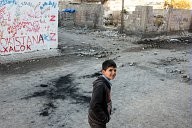
The uprising of the Kurds
Alexandre Afonso / Le Pictorium
LePictorium_0141270.jpg
The uprising of the Kurds: Diyarbakir and Nosaybin Kurds make up roughly one third out of Turkey's eighty million citizens. Though an almost absolute majority in the south-eastern provinces, they have hardly any rights and are faced with systemic discrimination that is coming to its tragic phase as testified in these images. Kurds have first tried political cooperation, the June elections for the first time brought a Kurdish party to the state parliament. This success and the possibility of a joint Turkish/Kurdish opposition as the Kurdish cause of political emancipation has rallied other minority and progressive votes inside the mainstream Turkish society frightenned the rulling AKP party, that before the repeated november elections – for they were unable to build a coalition- one sidedly ended the long ceasefire with the outlawed Workers party of Kurdistan (The PKK). Yet the Kurds were patient even during Ankara's unprovoked offensive, yet they succeeded in dividing the country among ethnic lines. After highly controversial elections that gave power to the AKP party, the Kurds were once again alone, if they could not strive for cooperation and a fairer Turkey, they should strive for autonomy. If the legal political activity of HDP party proved unsuccesfull, the initiative is once more on the PKK guerillas, if Turkey bombed the rural areas and mountain bases, the PKK resorted to a new tactic, trough their youth branches, they declared autonomy in certain urban centers, the heart of Kurdish community. Hope was that Turkey will be more lenient selective in attacking heavily populated areas as opposed to ruthlessly devastating the countryside far from any witnesses. This was not the case. Turkey responded with brutal force when attacking the guerillas seeking autonomy in their own community, aid workers are prohibited to access the wounded civilians caught in the crossfire, with dozens of dead each day. The official numbers are high enough yet they are impossible to determine as observers and journalists are denied access with threats of deportation or even physical harm while the locals who communicate with the press risk the possibility of a much more brutal consequences. The following photographs from Diyarbakir and Nosaybin, two of the seven cities that have districts under 24-hour curfews, cannot capture the conflict as one of the most oppressive regimes in history does everything in its power to make witnessing impossible. But the images do testify the conflict, as Ankara is using this conflict as an excuse for ethnic cleansing and general oppression of the Kurdish people. This is the only side that is accessible to the photojournalists. To make matters worse, most of the people in the photographs are forced to flee their homes for the second time in their lives. In the first uprising of the PKK in the nineties, Turkey used this as an excuse to empty the countryside, the cities in eastern Turkey tripled in size, now it's using the same excuse to reorganize the cities. The conflict is in its first phases yet its brutality is apparent, with reports of massacres by the government, mass deportations and general oppression in Turkish Kurdistan.
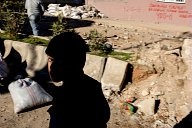
The uprising of the Kurds
Alexandre Afonso / Le Pictorium
LePictorium_0141256.jpg
The uprising of the Kurds: Diyarbakir and Nosaybin Kurds make up roughly one third out of Turkey's eighty million citizens. Though an almost absolute majority in the south-eastern provinces, they have hardly any rights and are faced with systemic discrimination that is coming to its tragic phase as testified in these images. Kurds have first tried political cooperation, the June elections for the first time brought a Kurdish party to the state parliament. This success and the possibility of a joint Turkish/Kurdish opposition as the Kurdish cause of political emancipation has rallied other minority and progressive votes inside the mainstream Turkish society frightenned the rulling AKP party, that before the repeated november elections – for they were unable to build a coalition- one sidedly ended the long ceasefire with the outlawed Workers party of Kurdistan (The PKK). Yet the Kurds were patient even during Ankara's unprovoked offensive, yet they succeeded in dividing the country among ethnic lines. After highly controversial elections that gave power to the AKP party, the Kurds were once again alone, if they could not strive for cooperation and a fairer Turkey, they should strive for autonomy. If the legal political activity of HDP party proved unsuccesfull, the initiative is once more on the PKK guerillas, if Turkey bombed the rural areas and mountain bases, the PKK resorted to a new tactic, trough their youth branches, they declared autonomy in certain urban centers, the heart of Kurdish community. Hope was that Turkey will be more lenient selective in attacking heavily populated areas as opposed to ruthlessly devastating the countryside far from any witnesses. This was not the case. Turkey responded with brutal force when attacking the guerillas seeking autonomy in their own community, aid workers are prohibited to access the wounded civilians caught in the crossfire, with dozens of dead each day. The official numbers are high enough yet they are impossible to determine as observers and journalists are denied access with threats of deportation or even physical harm while the locals who communicate with the press risk the possibility of a much more brutal consequences. The following photographs from Diyarbakir and Nosaybin, two of the seven cities that have districts under 24-hour curfews, cannot capture the conflict as one of the most oppressive regimes in history does everything in its power to make witnessing impossible. But the images do testify the conflict, as Ankara is using this conflict as an excuse for ethnic cleansing and general oppression of the Kurdish people. This is the only side that is accessible to the photojournalists. To make matters worse, most of the people in the photographs are forced to flee their homes for the second time in their lives. In the first uprising of the PKK in the nineties, Turkey used this as an excuse to empty the countryside, the cities in eastern Turkey tripled in size, now it's using the same excuse to reorganize the cities. The conflict is in its first phases yet its brutality is apparent, with reports of massacres by the government, mass deportations and general oppression in Turkish Kurdistan.

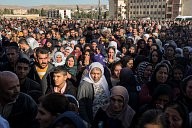 The uprising of the Kurds: Nosaybin / Alexandre Afonso
The uprising of the Kurds: Nosaybin / Alexandre Afonso